STAR POWER THE BAR REPORT
Michelinstarred chefs are making their marks on Canada
Chef Ryusuke Nakagawa
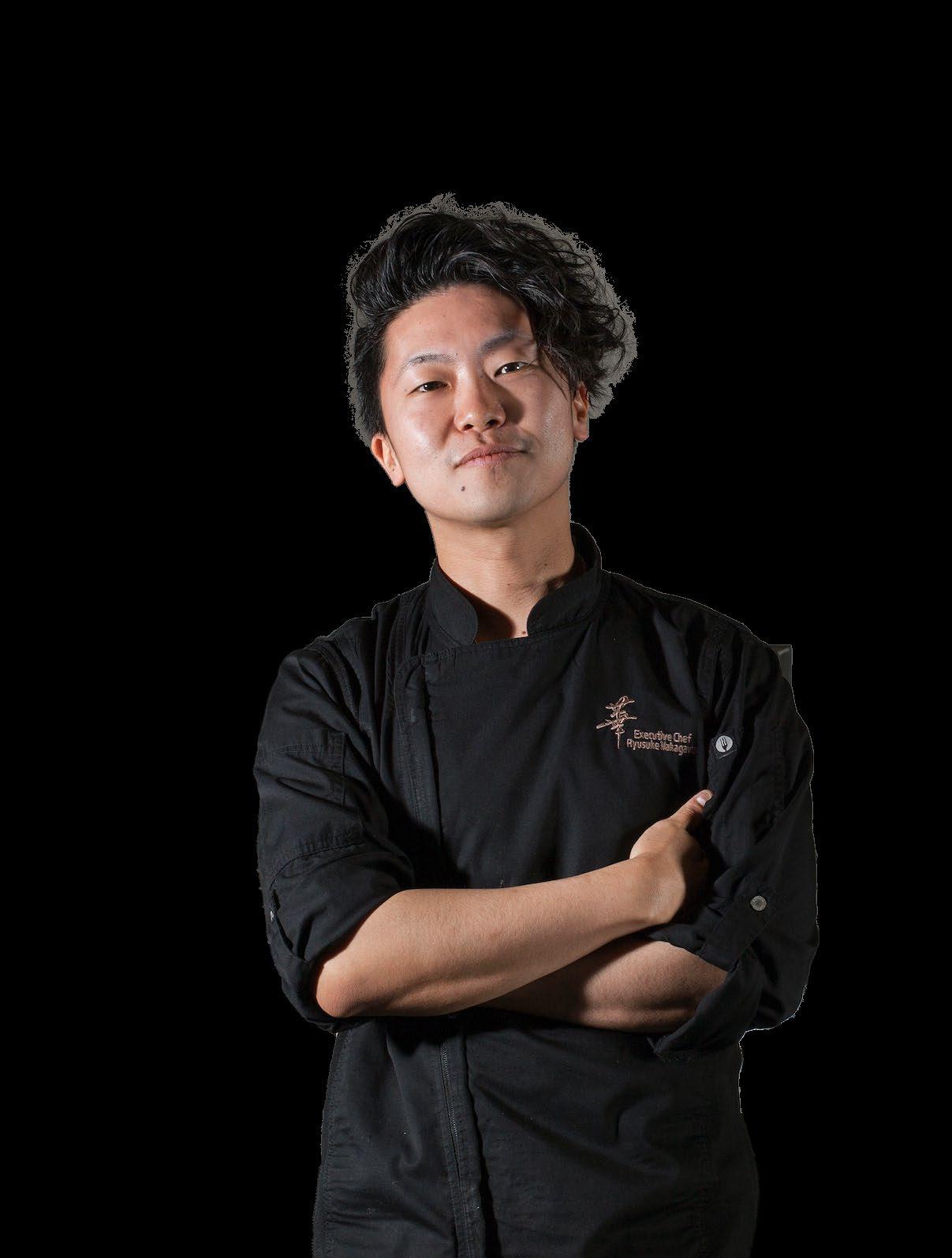
Aburi Hana, Toronto
It's a brandnew world for the beveragealcohol segment










































1 2 3

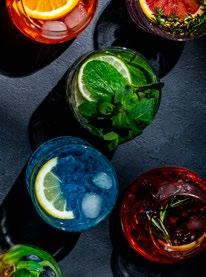


JULY/AUGUST 2023 FOODSERVICE AND HOSPITALITY 1 FOODSERVICEANDHOSPITALITY.COM VOLUME 56, NO.5 | JULY/AUGUST 2023 DEPARTMENTS 2 FROM THE EDITOR 5 FYI 8 SERVING CLARITY IN FOODSERVICE 64 INGREDIENT PROFILES THE FOOD ISSUE: SHINING THE SPOTLIGHT ON CHEFS, PRODUCERS AND SUPPLIERS 21 FEATURES 9 SUCCESSFUL SYSTEMS The Top-10 characteristics of successful hospitality franchisors 11 LEADING THE WAY KML launches new leadership summit with a twist 14 A LOT AT STEAK Operators re-think the role beef plays on menus 53 14 COVER PHOTO BY PAULA WILSON
THE GREAT EVOLUTION Non-animal-based proteins are changing the game for foodservice professionals
THE HISTORY OF CANADIAN RESTAURANTS: A timeline of hospitality "firsts" for pubs, taverns and restaurants in Canada 31 THE FOOD ISSUE
CHEF PROFILE: Michael Caballo and Tobey Nemeth 34 CHEF PROFILE: Ryusuke Nakagawa 36 CHEF PROFILE: Masaki Saito 39 CHEF PROFILE: Mike Robbins 42 SUPPLIER PROFILE: Pluck Tea 44 SUPPLIER PROFILE: Northfork Bison 45 SUPPLIER PROFILE: NotCo 46 PRODUCER PROFILE: Organic Ocean 48 PRODUCER PROFILE: West Avenue Cider House 50 SUSTAINABLE ACTION Gusto 54 Restaurant Group is committed to reducing its environmental impact 52 A BREATH OF FRESH AIR Air purifiers have become must-have pieces of equipment for restaurants 55 THE 2023 BAR REPORT A new generation of consumers turns beverage-alcohol trends upside-down 59 SOMMELIER PROFILES 59 Kelcie Jones 60 Justin Madol 61 Mario Cagnetta 63 RAISING THE BAR Hotel Lugano Dante’s Bar showcases beverage innovation
21
23
31
Our relationship with food continues to grow, evolve and become more layered. Compared to other nations in the world with a long and rich culinary history, Canada is now coming of age with respect to the foods we grow and produce while gaining a better understanding of the complexity of our food history. Having morphed from a nation once focused on food staples such as meat and potatoes, and dominated by the two founding British and French cultures, Canada is now one of the most diverse countries in the world, home to many rich cultures that span the globe. It’s gratifying to see that Canadians are finally starting to understand the depth of Indigenous cuisine, imbuing us with a unique and essential component of our history.
As Foodservice and Hospitality celebrates its 55th birthday this year, it’s clear just how much restaurants and the food they serve have changed through the past six decades. It’s also gratifying to see how young Canadians are so at home with the wide range of product that exists because they’ve been exposed from a young age to global flavours. In the process, our relationship with food has moved beyond sustenance and is now taking on new dimensions. And as functional foods begin to have an impact as
COMING OF AGE
well, this will continue to add new complexities to our understanding of food. It speaks to a brave new world that meshes science with functionality and flavour (see story on p.21). One can only imagine the breadth of new products consumers will be introduced to do in coming years.
Immigration patterns continue to fuel change, the cornucopia of foodstuffs and dishes we can expect to indulge in remains unlimited as does the breadth of our restaurant landscape. As an interesting sidenote, we’re pleased to present a culinary timeline in this issue, produced by Professor Jeff Stewart, Board Member, Food Day Canada. It highlights the changes and growth that have taken place in the restaurant landscape over the past 60 years (see story on p.23).
Just as food continues to evolve, Canadians’ attitude towards it is also undergoing changes. According to a recent survey conducted by Angus Reid, Canadians are more concerned with ingredients, where food comes from and its safety. Here are some of the key findings from that survey: 91 per cent of Canadians feel it’s important to understand the ingredients they are putting into their body; 84 per cent are concerned about where their food comes from; 79 per cent are big advocates of farm-to-table foods and 76 per cent of Canadians feel safer with the ability to track their food to its source.

As we celebrate the 20th anniversary of Food Day in early August, a concept launched by the late Anita Stewart to celebrate Canada’s bounty, (see story on p.21), let’s revel in just how intrinsic food is — not just to our survival but to our enjoyment and appreciation of life. FH
ROSANNA CAIRA
@foodservicemag
facebook.com/foodservicehospitalitymagazine instagram.com/rosannacaira

2 FOODSERVICE AND HOSPITALITY JULY/AUGUST 2023 FOODSERVICEANDHOSPITALITY.COM FROM THE EDITOR
NICK WONG, LOCATION PROVIDED BY VIA CIBO
EDITOR & PUBLISHER ROSANNA CAIRA
MANAGING EDITOR AMY BOSTOCK
ASSISTANT EDITOR NICOLE DI TOMASSO
ART DIRECTOR COURTNEY JENKINS
DESIGN ASSISTANT JENNIFER O’NEILL
SOCIAL MEDIA MANAGER JANINE MARAL
WEBSITE MANAGER TYLER BECKSTEAD
DIRECTOR OF BUSINESS DEVELOPMENT




WENDY GILCHRIST
ACCOUNT MANAGER CATHI KREWICKI
ADMINISTRATIVE ASSISTANT DANNA SMITH
ACCOUNTING SERVICES DANIELA PRICOIU
CIRCULATION PUBLICATION PARTNERS
ADVISORY BOARD

ASCARI HOSPITALITY GROUP JOHN SINOPOLI
BROWNS RESTAURANT GROUP BRUCE FOX
BELLHOUSE HOSPITALITY INC. SCOTT BELLHOUSE

CHARCUT RESTAURANT CONNIE DESOUSA, JOHN JACKSON
LACTALIS CANADA IVEN ZANARDO
MAPLE LEAF SPORTS & ENTERTAINMENT DAN MORROW
MTY GROUP MARIE-LINE BEAUCHAMP
NARAMATA INN NED BELL
PARAMOUNT FINE FOODS MOHAMAD FAKIH
SOTOS LLP ALLAN DICK

















THE HOUSE OF COMMONS JUDSON SIMPSON UNIVERSITY OF GUELPH, SCHOOL OF HOSPITALITY & TOURISM MANAGEMENT BRUCE MCADAMS
GARLAND CANADA MARY CHIAROT
FOODSERVICEANDHOSPITALITY.COM
foodserviceandhospitality.com Published eight times per year by Kostuch Media Ltd., Mailing Address: Kostuch Media Ltd., 14 – 3650 Langstaff Rd., Ste. 33, Woodbridge ON L4L 9A8 Tel: (416) 447-0888, Fax (416) 447-5333, website: foodserviceandhospitality.com. The reproduction of this magazine, in whole or in part, is expressly prohibited without the permission of the publisher. Copyright Foodservice and Hospitality magazine © SUBSCRIPTION RATES: 1-year subscription, $27.50; U.S. $55; International, $65. Canada Post – “Canadian Publication Mail Product Sales Agreement #40063470.” Postmaster send form 33-086-173 (11-82). RETURN MAIL TO: Publication Partners, 1025 Rouge Valley Dr., Pickering ON L1V 4N8 Member of CCAB, a Division of BPA International. Printed in Canada on recycled stock. EST. 1968 | VOLUME 56, NO 5 | JULY/AUGUST 2023 Have the top business headlines conveniently delivered to your inbox every Tuesday & Thursday morning Hospitality Headlines SUBSCRIBE FOR FREE TODAY READ SHARE SUBSCRIBE Subscribe for FREE today! foodserviceandhospitality.com/newsletter/
To subscribe to F&H, visit





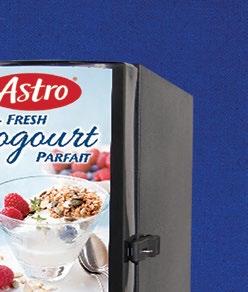








. . . INTRODUCING . . . Fresh Yogourt Dispensing Solution ...... A Unique Innovation to Serve Fresh, Customizable Yogourt Parfaits ...... Featuring Yogourt TM WWW.LACTALISFOODSERVICE.CA @LACTALISCANADAFOODSERVICE Let’s connect
AND UPDATES FOR THE FOODSERVICE INDUSTRY
TASTE OF PLACE
The Culinary Tourism Alliance launches the Great Taste of Canada
The Culinary Tourism Alliance (CTA) has launched the Great Taste of Canada, the ultimate field guide to mouthwatering eats, hands-on food experiences and unique tastes of place across the nation.

Made possible through support from the Tourism Industry Association of Canada (TIAC), the Great Taste of Place brings together more than 40
destinations, sector organizations and tourism stakeholders from coast to coast to coast to share and tell stories of Canadian foodways and taste of place experiences. Whether travellers are helping a beekeeper with apiary work, learning to filet a fish with an Indigenous chef or sipping their way through a new wine region, the guide will tell the stories of the people behind it all.
The Culinary Tourism Alliance works with communities to grow food tourism by leveraging the history, heritage, and culture behind the food and drink that makes each destination unique. Its mission is to ensure food tourism is a meaningful and sustainable contributor to local economies in destinations worldwide.
"By developing a robust national culinary tourism campaign, we showcase Canada's diverse culinary heritage and increase our global competitiveness as an international gastronomic destination," says Beth Potter, president and CEO of TIAC. "The Great Taste of Canada is a delicious catalyst for exploration, cultural exchange, and economic growth. We’re thrilled to support an initiative that not only feeds the appetite of travellers, but also ignites a passion for Canada's culinary treasures."
Canada's food scene is widely recognized as a smorgasbord of gastronomic journeys, shaped by the rich history, heritage, and cultures across the country. According to the CTA, this new initiative promises to showcase a plethora of experiences where food enthusiasts can embark on unforgettable adventures and unparalleled sensory experiences.
"It’s through savoring local flavors, sharing stories, and celebrating our foodways that we invite visitors from around the world to visit Canada and go somewhere delicious," says Rebecca Mackenzie, president and CEO at the Culinary Tourism Alliance. "Destination partners across the country have helped to inform and create this incredible resource for foodies and food connected consumers. Every bite becomes a gateway to unforgettable experiences.” FH
JULY/AUGUST 2023 FOODSERVICE AND HOSPITALITY 5 FOODSERVICEANDHOSPITALITY.COM
NEWS
MONTHLY
NOW OPEN: RISTORANTE SOCIALE


Firehouse Subs has opened its first restaurant in Switzerland and has signed a development agreement to launch in Mexico later this year, marking the beginning of the brand’s expansion plan globally, with the first opening outside North America.
The team behind Toronto’s Enoteca Sociale, a Michelin Bib Gourmand award recipient, has launched its latest dining venture, Ristorante Sociale.
Located in the city’s King West neighbourhood, the restaurant offers an upscale dinner service that transitions into a celebration with live entertainment, including dining-room dancers and a nightly DJ.
The 3,700-sq.-ft. space can seat up to 110 guests and is inspired by 1970s Italian steakhouses, featuring deep, earthy hues paired with gold accents and chic walnut for an air of antique luxury. Designed by Westgrove Design Ltd., the restaurant also features millwork by J.C Millwork & Cabinetry and furniture by Studio 22.
Ristorante Sociale was conceptualized by partners Deni Di Tullio, chef Kyle Rindinella, chef Rocco Agostino and restaurateur
Max Rimaldi of Michelin-awarded Enoteca Sociale. In addition to Rindinella’s extensive culinary knowledge, Di Tullio’s 30 years of entrepreneurial and management expertise are a driving force behind this new venture and the continuing growth of Sociale Group.
Rindinella has curated a sophisticated menu of Roman flavours with Tuscan influence, including fresh pasta, seafood and steaks, as well as classic Roman wines and signature cocktails that capture the essence of Italian gastronomy.
UPWARD TRAJECTORY
Swiss Chalet has announced new restaurant openings in 2023 in the Ontario communities of Burlington, Newmarket, Don Mills, Brampton, and Calgary with plans for more locations to be announced later this year. The latest Swiss Chalet locations boast a new look and feel for the brand, including testing takeout-ordering kiosks and a Chalet Valet pre-paid pickup lane at select locations. Many pre-existing locations are also being renovated with the new design.
“We are in growth mode and on the lookout for different locations in communities we believe Swiss Chalet can really thrive in,” says Mark Eaton, Chief Development Officer of Real Estate.

BUILDING CREDIT
Tim Hortons has introduced its new Tims Credit Card from Tims Financial, a division of the company established to give Canadians financial tools to manage their everyday finances. The Tims Credit Card can be applied for, approved and managed entirely through the Tim Hortons mobile app. The Tims Credit Card is a Mastercard, powered by Neo Financial. It has no annual fee and earns Tims Rewards Points everywhere, with up to five points per dollar on most gas, grocery and transit purchases, and up to 15 points per dollar when you use the card on eligible purchases at a Tim Hortons restaurant and scan for Tims Rewards.
Additionally, there will be a version of the Tims Credit Card offered to Canadian residents who have limited or no credit history, such as students and newcomers that will earn Tims Rewards Points and can help build their credit.

6 FOODSERVICE AND HOSPITALITY JULY/AUGUST 2023 FOODSERVICEANDHOSPITALITY.COM
EXPANSION TARGET
Odd Burger has signed its first U.S. Area Representative Agreement for the development of 20 locations in Washington State over the next eight years. The agreement was signed with 5th Group Holdings Ltd., a commercial construction and franchise development company based out of British Columbia.
The 5th Group Holdings Ltd. team is led by Luke Ceraldi, John Bowker and Clayton Gunner, a team with nearly 10 years of commercial construction experience in the U.S. Ceraldi and Bowker are also developing two Odd Burger sites in Victoria, with their first location set to open this fall.
In the U.S., Odd Burger is growing exclusively through a territory development strategy whereby the company sells the franchise development rights of each state to area representatives who know the local market and can assist with growth in those regions. The area representatives secure franchise partners, assist with site selection, construction and ongoing operational support for franchisees. In exchange for developing the territory, the area representatives get a percentage of the franchise fee, development fees and recurring royalties on operational locations in their territory.
The company is currently seeking territory developers in the following U.S. states: Alabama, Alaska, Arizona, Arkansas, Colorado, Delaware, District of Columbia, Florida, Idaho, Iowa, Kansas, Massachusetts, Mississippi, Missouri, Montana, Nevada, New Hampshire, New Jersey, New Mexico, Ohio, Oklahoma, Oregon, Pennsylvania, Tennessee, Utah, Vermont, West Virginia and Wyoming.

“The U.S. market has always been our primary expansion target and we’re now ready to open our first set of U.S. locations,” says James McInnes, CEO and co-founder of Odd Burger. “The opportunity for Odd Burger is tremendous in the U.S., and we’re fortunate to work with the talented team at 5th Group Holdings Ltd.”
TERROIR TRANSFORMATION
In partnership with Food Tourism Strategies, Terroir Symposium is returning for its second year in Calgary from Sept. 30 to Oct. 2, 2023 with the theme of Transformation.
The Symposium’s opening two days will be hosted at SAIT with activities in the butchery room, bakery, chocolate lab, Highwood Dining Room, demo kitchen, Hospitality Hall and the theatre providing hands-on demos and workshops. The third day will be held in the Arts Commons at the Jack Singer Concert Hall with a full day of sessions. In conjunction with the three days of programming, select Terroir guest chef speakers will partner with local restaurants and chefs for the Signature Dinner Series bringing together industry and consumers for an evening of food and connection.
“Terroir Symposium is about people and building community with the goal of providing a space to share ideas and resources to support businesses and careers,” says Arlene Stein, founder of Terroir.
“Collaborating with like-minded individuals and organizations helps to support the hospitality industry.”
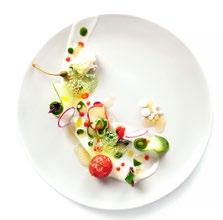
“We have such an exciting culinary scene in Calgary,” says Tannis Baker, co-founder of Food Tourism Strategies. “From award-winning chefs and restaurants to the exploding craft beverage industry to the heartland of amazing agricultural producers right in our backyard, we’re really excited to celebrate and share our story.”
LEADERSHIP CHANGES
Robert Masson has been appointed Chief Development Officer at Redberry Restaurants. With signed agreements for more than 300 new Burger King and Taco Bell locations over the coming years and Redberry’s rapid expansion during the past 12 months, this growth has prompted the creation of a new role to fulfill the company’s strategic vision of being the largest-and fastest-growing QSR franchisee in Canada.
Masson joined Redberry as Chief Financial Officer more than two and a half years ago. In his time there, he’s demonstrated a wealth of industry knowledge and excellent leadership skills. This combination of skills and experience makes Masson uniquely qualified to lead the real estate, design, construction and development teams, working closely with Restaurant Brands International (Burger King) and YUM! Brands (with 150 and 200 new builds respectively).
Additionally, Gregory Pope has joined the company as its new Chief Financial Officer. He has led finance departments at brands such as Boston Pizza International, Golf Town, Toys R’ Us and Sporting Life. As Redberry grows and scales, Pope’s expertise in leading financial and information-technology functions will be a critical asset to Redberry.

JULY/AUGUST 2023 FOODSERVICE AND HOSPITALITY 7 FOODSERVICEANDHOSPITALITY.COM
Robert Masson, Chief Development Officer, Redberry Restaurants
LOOKING TO THE FUTURE
Innovations highlight the future of food
 BY VINCE SGABELLONE
BY VINCE SGABELLONE
How would you define innovation?
Many dictionaries describe it as something new or different. After participating in the SIAL 2023 Food Innovations show as the resident foodservice expert, I would define innovation in food today as being all about new flavours, new products, and new technology.
NEW FLAVOURS
When searching for new flavours, it makes sense to look beyond our borders. At this year’s show, many parts of the globe were well represented, with beverages being the most common vehicle for new flavours. There were plenty of new coffee blends on offer but interestingly there were also a wide array of new nonalcoholic beverages, and fruitbased beverages in flavours I hadn’t previously heard of.
Each of these beverage categories is poised for growth in foodservice due to the shifting demographic landscape in Canada. With immigration fuelling much of our population growth, and Circana’s latest CREST® data showing that people of colour now make up almost a third of all foodservice visits, we can expect to see new flavours emerge. After all, consumers want flavours that remind them of their home countries. These consumers are less familiar with the legacy beverages on offer. Meanwhile, as the fastest-growing cohort in foodservice, Gen
Z is familiar with legacy beverages but less inclined to choose them.
NEW PRODUCTS
The show also displayed a wide assortment of new snack items — from baked goods to salty snacks and savoury grab-and-go menu options. Similarly, many of these products were sourced globally, and appeal to Gen Z, who prefer allday snacking over structured mealtimes. The next big category of new products on display were plant-based options. These selections were more suitable for retail food
channels, but we can expect to see some of them make their way into foodservice as this category matures and gains broader acceptance.
The wonderful cheeses from all around the world were the highlight of the show for me. Canadian cheese producer Stonetown Artisan Cheese Ltd, was this year’s Grand Championaward winner in the firm-cheese category.
Additionally, Canada-based Millennia Tea Inc. won the SIAL Innovation Gold Award for its flash-frozen raw organic tea.
NEW TECH
Dana McCauley, CEO of the Canadian Food Innovation Network (CFIN), hosted a session at the show. The network’s mission is to champion a collaborative food innovation culture that generates transformative opportunities. She presented a brief snapshot of a few of the 34 foodtech projects the network supports, including one company working on a biodegradable plastic that breaks down and can be added to fertilizer and another that is hyper-localizing ice manufacturing.
The work being supported by the CFIN points the way to a new horizon for food innovation. As Paul Uys, external director, Ontario Agricultural College, University of Guelph, was quick to point out, brands do not need to reach 10 steps ahead when they innovate. Just taking a few steps at a time can keep them ahead of the competition and keep customers engaged. With more than 40 years of global food expertise on his resume, Uys participated in a panel discussion on what comes next in food innovation. FH

8 FOODSERVICE AND HOSPITALITY JULY/AUGUST 2023 FOODSERVICEANDHOSPITALITY.COM SERVING CLARITY IN FOODSERVICE
Vince Sgabellone is the director of Client Development and Foodservice Industry analyst at Circana. He can be reached at vince.sgabellone@circana.com
FREEPIK.COM/@NOORTAYYBA007
THE 10 COMMANDMENTS
Atits core, franchising is one of many methods by which businesses expand. The term “franchise” is just another word for “permission.” A franchisor grants permission to others to make use of the franchisor’s intellectual property and “system,” which the franchisor has developed for operating the underlying business. Franchisees are simply people who make the decision that they want to operate their own business using that intellectual property and system rather than trying to start their own business. For this right, they are prepared to pay various fees to the franchisor and take on numerous obligations in how the business can be run. The particulars of what is being granted and the rights
BY ALLAN D. J. DICK
and obligations are typically contained in a series of contracts between the franchisor and the franchisee. As franchising as a business model is regulated in many jurisdictions, including in six of Canada’s provinces, legislation also exists which overlays the buying and selling of franchises and in their operation.
Most franchisors share common goals. However, their rates and degree of success vary greatly. This article will examine the top 10 characteristics of successful franchisors operating in the hospitality space from a career spanning 40 years working with hundreds of franchise systems. Approximately half of all franchise systems operate in these industries.
1Their systems sell products and services the public wants.

Franchisors in the hospitality industries typically started life as unit restaurants or hotels/ motels which successfully sold products and services to an appreciative customer base. Others — both because they liked the offerings and the financial model they believed existed for the operation of the underlying business — became interested in replicating the success of the founders in those businesses. It is the number-1 characteristic of successful franchisors that they make the best decisions to keep their offerings desirable in the marketplace. Customers of their brands must continue to embrace
the value proposition of the offerings. As a corollary, successful systems' franchisees identify with, are proud of and support the brand, products and services as much as their franchisors. A recent announcement by a large restaurant franchisor of the closing of hundreds of units can be mostly attributable to the failure of the system in this key area.
2They are instrumental in creating a profit pool large enough to support their businesses and the businesses of their franchisees and they share equitably in the profits.
A non-franchised business calculates its profits simply.
It deducts its expenses from its revenues. For a franchised business, those expenses include various line items involving payments which are made directly or indirectly to their franchisors and entities related to the franchisors. For the franchisors, the revenues they generate must create profit levels that allow them to cover their expenses in running their businesses as franchisors and provide an expected rate of return to the franchisees. As one envelope, all of the revenues generated by the system have various offsetting expenses. Successful franchisors find ways to maximize the revenues from the offerings within their systems, minimize the expenses for both
the franchisees and themselves and create profit structures or a sharing of these profits for both parties, which justify the investment that both make, and continue to make, in the systems. A simple example is that franchisors in the hospitality area have always enjoyed significant purchasing power. They acquire inputs used by their systems at reduced costs. They usually earn rebates from these purchases. Franchisors' abilities to reduce costs and earn rebates through this purchasing power become reflected in how they operate their systems. Do they pass on the savings and revenues? If so, how? The handling of this one aspect of franchising can be critical to a system's success.
JULY/AUGUST 2023 FOODSERVICE AND HOSPITALITY 9 FOODSERVICEANDHOSPITALITY.COM SLUG HERE LEADERSHIP
These 10 characteristics are the trademarks of successful hospitality franchisors
3They recognize the key attributes of successful franchisees, and they seek out franchisees who either have these attributes or can be successfully trained to have those attributes.
All franchisees are not created equal. A franchisee who is good for one system may be a total failure in another. Franchisors know what it takes to be a successful franchisee in their systems, and they recruit accordingly, often utilizing an array of technological tools to identify desirable franchisees. In these industries, franchisees must be willing and able to make a lengthy commitment and have shown aptitude for working long hours, following systems, managing people, loving guest service and having enough resources to endure challenging times.
franchisor handles that situation knowing a court or arbitrator is unlikely to let the franchisor terminate the franchise becomes a critical component to success.
5
They utilize compliance personnel and tools as a means of providing support and guidance.
They “police” their systems to ensure compliance for the benefit of the system as a whole and not as a means to eliminate franchisees for purposes of churning. As a follow up to the last characteristic, franchisees benefit by having franchisors that are diligent in maintaining the system across the franchised network. Modern technology tools and strategies exist for monitoring and addressing compliance. Successful hospitality franchisors invest in these systems and use them appropriately.
more money if they were allowed to, usually at their expense. They are transparent generally as to what each side’s profit silos are and how they co-relate. They and their franchisees understand that franchisors can make errors in the exercise of their business judgment and that it is their right to do so. Despite this right, they appreciate the impact of their bad decisions on the franchise system, and they find ways to mitigate the impact of bad decisions upon the franchisees.
7
They understand and plan for the different stages of system growth.
with this in mind. Similarly, and relatedly, they have succession strategies both internally and for their franchisees.
9
They establish systems for engaging their franchisees to obtain all appropriate input from those who are customer-facing and who made investments into the systems.
That can be done by establishing councils or franchisee associations, or working groups involving franchisees. There are different ways for franchisors to obtain good input from this valuable resource while maintaining their clear role in controlling their systems. 10
They understand they are operating in a regulated industry, and they care to become experts in the laws affecting their businesses.
4
They have franchise agreements that permit them to exercise control over the overall system and the individual units, but they exercise their rights and enforce their agreements fairly, with understanding and significant support befitting the investment and commitment made by the franchisees.
The fact franchise agreements seem very one-sided in favour of the franchisor is completely understandable. A franchisor must be able to operate a cohesive system. However, ultimately, franchisors are dealing with people who invested in them. Breaches by franchisees can and do occur regularly. A franchisee runs out of eggs and instead of asking the franchisor what to do, it buys a few across the road. Yes, that should never happen. Yes, that is a breach. How the
6 They ensure that their franchisees understand, and are comfortable, with the differences over what aspects of the system are controlled by which party and how the allocation of these controls and the overall system works reasonably on behalf of both.
Franchisors and franchisees perform different functions in good systems. Franchisors that succeed have drilled these differences into their wouldbe and existing franchisees. Franchisees then understand and appreciate why they can't purchase staple items off standard. They understand that franchisors control the concept. They look for proper ways to contribute but understand which rights they bought and which they didn't buy. Good franchisors realize that restaurant franchisees, in particular, will figure out how they could make
Franchising is an organic journey from establishment, to early days, to growth, to maturity, to exit. Successful franchisors understand from the beginning how each of these stages differ, how their own capital requirements differ, how their organizational structures will change, and they are in a constant state of planning for the next stage, to ensure they occur as seamlessly as possible.
8
They design systems that work at the unit level as well as the multi-unit level.
They generate investment opportunities within their systems so franchisees prefer to invest within their own franchise systems than elsewhere. Yet, they understand the difference between what it takes to be a successful multiunit operator from having unit success. Their systems are designed from the beginning
For that, they retain counsel with all the requisite legal and business experience to be by their side in every aspect of their businesses — from trademarking, to structuring, to franchise sales, to performance, to handling issues and dispute, to capital needs, to guiding system changes to succession.
Franchising in the hospitality space is long-established. Experienced franchise counsel has likely seen it all and thinks about aspects of the future of the business and the industries on a daily basis. That experience can be invaluable in helping franchisors exceed in their business goals. FH

10 FOODSERVICE AND HOSPITALITY JULY/AUGUST 2023 FOODSERVICEANDHOSPITALITY.COM
Allan D. J. Dick is a partner in Sotos LLP (sotosllp. com), Canada's largest, most experienced law firm serving businesses participating in franchise industries locally, nationally and globally. Allan can be reached at adjdick@sotos.ca or by cell at 416-805-8989.
KML launches new leadership summit Leading the way
 BY AMY BOSTOCK AND NICOLE DI TOMASSO | PHOTOS BY: WAYNE LINDO
BY AMY BOSTOCK AND NICOLE DI TOMASSO | PHOTOS BY: WAYNE LINDO
Kostuch Media Ltd. (KML) held its inaugural Top 30-Under-30 Leadership Summit: Future Forward June 13 at the Sheraton Centre Toronto. Dubbed “A Leadership Summit with a Twist,” the event brought together current leaders and tomorrow’s leaders to dialogue on the most important and pressing issues of the day.

Approximately 150 attendees gathered for a packed day of educational panels, awards presentations and networking opportunities. The day kicked off with the presentation of the Top 30-under-30 Awards following a networking breakfast.




“Being here today in person to congratulate this amazing group of leaders and future game-changers within our industry is a huge honour for me,” said Chef Imrun Texeira, former Top-30-Under-30 winner who presented this year’s awards. “The class of 2023 is among the strongest group in recent years to represent job segments from chefs
to hoteliers to housekeepers to foragers and more. They’re young, they’re smart and they’re entrepreneurial.”
Re-Writing the Rules of Recruitment & Retention
The first panel of the day, Re-Writing the Rules of Recruitment & Retention, provided an update on the current labour market, explored new recruitment strategies and examined the role of leadership development in company culture. Moderated by Bruce McAdams, associate professor at the University of Guelph, the panel included (from left to right) Sanjay Venu, regional director of Operations, Earls Kitchen + Bar; Rebecca Gordon, manager of Anita Stewart Food Lab; and Brian Cammack, regional VP of Human Resources, Marriott
JULY/AUGUST 2023 FOODSERVICE AND HOSPITALITY 11 FOODSERVICEANDHOSPITALITY.COM
Chef Imrun Texeira
Hotels of Canada.
Fortunately, Cammack said Marriott has seen job vacancies decrease. “Things are better, but last year, we had a record number of open positions in our industry,” he said. “At the same time, we saw record low unemployment, which is tough combination. We’re still hovering at about a five per cent unemployment rate. We have to be smart about how we steal more than our fair share of the talent that’s out there.”
Venu expressed a similar sentiment. “The world is coming back to life and things cost money, so we’re starting to see people come back. The new openings are creating excitement and there’s a path forward of growth and opportunity,” he said.
In terms of new approaches to recruitment, Cammack referred to the idea building [internal] customer relationships, adding that Marriott has been focusing on “relationships with applicants or associates who want to join the organization. We have a product we’re selling, which is an employment experience, and it has to be relevant and more meaningful than ever before by taking a look at brand offerings and [flexibility] to capture talent.”
In comparison to pre-pandemic, Venu mentioned the growth of virtual recruitment and the many benefits it offers. “We’re always looking to upgrade our talent, and if you’re not in that market then you’re [missing out on new talent pools],” he said. “The use of LinkedIn Recruiter has always been around but it has become a larger part of what we do in our daily routines and impacts our day-today operations. Earls has a digital recruiting team and an internal recruiting team in-store.”
In her surveys and research studies with hospitality workers on the topic of recruitment, Gordon said initial conversations were largely about wages, but workers are also looking for opportunities for growth and development and a positive work culture that cares for its employees.

“When I’ve asked workers what

Green Awards
Following a networking lunch, the KML Green Leadership Awards were presented in both the restaurant and hotel categories.
“It’s been great to see an increasing number of initiatives continue both in the restaurant and hotel space — whether it’s been a reduction in plastics, a focus on eliminating food waste, the growth of local produce as a way to reduce our carbon footprint and a host of other initiatives that prove the tide really has turned and greening is now a part of our every day reality,” said Rosanna Caira, editor/publisher, KML. “Can we do more? Definitely. Do we need to get broader based to incorporate other operational areas and to move past the obvious areas of greening? Most certainly. While the pandemic might have put greening initiatives on the back burner for a couple of years, environmental stewardship is back stronger than ever, not just because consumers demand it, but also because it makes good business sense.”
This year’s Green Leadership Awards went to Langdon Hall Country House Hotel and Spa in the hotel category; Gusto 54 Restaurant Group in the restaurant category; and Fairmont Hotels and Resorts/Accor for the special Green Leadership Award For Outstanding Commitment to Environmental Stewardship.



a positive work culture looks like, they’ve said it’s being respected and being listened to by an employer, and not just being treated as one of many people in an organization. I think that’s good lesson that we can take and learn from,” she said.
Tech Talk
The second panel, Tech Talk, delved into the latest restaurant technology trends that have helped foodservice businesses save money, streamline operations, draw customers and boost sales. (From left to right) Moderated by Lee Jackson, senior VP of Digital Solutions at JLL, the panel included Greg Staley, GM of E-Pro Bot; Peter Mammas, president & CEO, Foodtastic; Ben Osmow, president & CEO, Osmow’s Restaurants; and Andrew Gnoinski, head of Enterprise, Deliverect.
Osmow said POS integration has been integral to the management of his family’s restaurant business, especially since the onset of the pandemic. Currently, delivery accounts for roughly 34 per cent of Osmow’s total sales.
“Amalgamating all the different platforms, such as DoorDash, SkipTheDishes, Uber Eats, into one allows us to focus on having our restaurant and our kitchen operations run smoothly,” he said. “We don’t have to check 10 different tablets anymore to see the order, where it’s coming from and if it’s pickup or delivery. That’s helped us in a big way, and we’re always focusing on efficiency and speed of service.”
At Foodtastic, which has completed roughly 15 acquisitions in the last 36 months, Mammas said the FSRs use technology platforms for things like inventory, reservations and scheduling while QSRs are seeing an uptick in self-service kiosks. “I think the whole restaurant industry was lagging in tech, but in the last few years it has really accelerated and will continue into the future,” he said. “We have about 40 different tech solutions and opportunities between all of our brands.”
Gnoinski proceeded to talk about some off-premise trends that have impacted businesses. “Delivery is here to stay. Operators now have what can be considered two competing forces in their restaurant and they have to satisfy both. Customers expect the best from you every time and you need the repeat business from them as often as possible to continue maintaining franchisor location profitability. Deliverect really tries to simplify and standardize those processes. However, the reality is operators have to maintain the in-store customers first. They need the most and the best service from staff, both front and back of house, so whatever you can do to simplify the off-premise business to allow staff to do their best is key.”


Osmow said delivery accounts for roughly 34 per cent of total sales, while Mammas said Foodtastic’s QSR brands in general sit at about 30 per cent and the FSRs are 10 per cent. He also noted some QSR brands are focused heavily on delivery, accounting for 70 per cent of total sales.

The panel ended with a conversation about the takeoff of robots in restaurants. In fact, E-Pro Bot has deployed

12 FOODSERVICE AND HOSPITALITY JULY/AUGUST 2023 FOODSERVICEANDHOSPITALITY.COM
Chef Jason Bangerter from Langdon Hall Country House Hotel and Spa, accepts award from Ryan Vader.
Jane Gibson, sponsor from Arterrra WInes, presents the award to Juanita Dickson.
Marina Elsener, Fairmont Hotels & Resorts/ Accor, accepts award from Rosanna Caira.
approximately 24,000 robots across the globe.
“These days, robots create a WOW factor,” said Staley. “We never sell a robot to replace a person. When I sell a robot, it’s all about the ROI. The three main benefits are combatting staff shortages and enabling increased productivity; upselling menu items; and attracting more customers with free advertising generated by customers on socials, which simultaneously reduces marketing costs.”
Sustainable Strategies
The Environmental Stewardship panel, (from left to right) moderated by Caira, kicked off the afternoon program, featuring Emily Robinson, Food Education manager, University of Guelph; Kate Longmire, VP, Foodservice Marketing & Innovation, Maple Leaf Foods Inc.; and Marina Elsener, director, Sustainability & DEI for Accor.
The discussion began around the evolution of what sustainability means to the industry.
“When the industry first started making inroads on sustainability, it was built on the mantra of reduce, re-use, recycle,” said Caira. “But now the definition of sustainability has changed quite dramatically and covers so much more.”
The panellists each took the opportunity to highlight what sustainability means to their organization.
“We define it as addressing the needs of our current consumer base and the current world, while still protecting the needs of the future,” said Longmire. “For us, it’s all-encompassing and it’s evolved from an avoidance strategy and simply not making things worse, to re-generation.”

Robinson says her research has shown that the traditional definition of sustainably — meeting the needs of the present without compromising the needs of future generations — has had to evolve over the last couple of decades because while it’s a “beautiful sentiment, what does that actually mean? As a restaurant operator, how can you actually apply that to your day-to-day operations,” she said, adding the discussion has moved from reduce, re-use, recycle to one more focused on achieving net zero and closed loop and trying to keep resources in a finite system.
While Fairmont/Accor has countless sustainability initiatives in place, Elsener







spoke to three of them during the panel: carbon, food and waste. Addressing the issue of carbon emissions, she said “In December 2019, we commenced the latest stage of our climate journey with a commitment to setting a science-based target [with respect to carbon emissions]. We have also made a longterm commitment to reach net-zero carbon emissions by 2050.”
The panellists went on to discuss how this evolving definition of sustainability has changed how their organizations approach the topic from a strategy standpoint.
“The major change is that before, sustainability was a strategy for our organization, and today it is our strategy,” said Longmire. “We have a blueprint that guides all we do and there are 35 initiatives within the blueprint that align with the company’s pillars of sustainability.”
Robinson remindied the audience that “the more we learn and understand about the impact of some of our daily choices, it becomes clear that some choices will have more impact [on the environment] than others. As a chef or restaurant operator, you have the ability to educate your consumers.
panellists included Trevor Lui, chef and founder, Quell; Rajesh Uttamchandani, Chief People Officer, Applyboard; Juanita Dickson, president, Gusto 54 Restaurant Group; and Kevin Barrington, manager, Talent & Culture Fairmont Hotels and Resorts.

“What does DE&I mean to you personally?" asked Cooper by way of introduction to the session. So, I want to ask our panellist, what does DE&I mean to you personally?”
“If I had to sum it up in one word, I’d say belonging,” said Dickson. “As a business, that means being able to provide opportunities regardless of who you are and to make you feel as if you belong.”
BUILDING SAFE SPACES

The final panel of the day focused on diversity, equity and inclusion in the hospitality industry. (From left to right) Moderated by Cyrus Cooper, professor and program coordinator at Centennial College, the
Lui then spoke to how businesses can ensure that they keep DE&I top of mind. “DE&I is about basic values,” he said. “Everyone is on their own journey and one of the biggest challenges we’re facing right now is that people are really scared of this topic. We were scared of recycling 15 years ago, now we’re scared of people. We always knew that the hospitality industry was flawed, but we really found out how flawed it was during COVID and we’re still having problems acknowledging those problems. The power structure [in the industry] is what’s preventing us from acknowledging them. So, I talk about DE&I as understanding and acknowledging that power structure in order to move forward.”
At Fairmont, Barrington says they’ve adapted their job descriptions and hiring practices to make it not only more inclusive, but welcoming to anyone who wants to apply and work for the company. “A big part of it is strategic partnerships,” he said. FH
The day wrapped up with the presentation of KML’s Tops in Hospitality Awards. These annual awards were presented to the two companies that achieved the greatest increase in sales on F&H’s 2023 Top 75 Report, published in the June issue of Foodservice and Hospitality magazine. One award is for top growth from a dollarvalue perspective, while the other recognizes percentage growth year-over-year.
The award for Top Dollar Growth was presented this year to MTY Food Group, which recorded a gross sales increase of $619.7 million on our Top 75 Report. The Quebec-based company reported $4.2 billion in gross sales for 2022, up from $3.6 billion at year end 2021. Renee St. Onge accepts award from Amy Bostock.
The award for Top Percentage Growth was presented this year to Mandarin Restaurants. The Brampton, Ont.-based company ex perienced a 135-per-cent increase in sales in 2022, reporting gross sales of $138.3 million. Tina Chiu accepts award from Amy Bostock.


FOODSERVICEANDHOSPITALITY.COM
JULY/AUGUST 2023 FOODSERVICE AND HOSPITALITY 13
at

Operators are working to strike a balance of quality
BY DANIELLE
quality and affordability with their beef menu items
DANIELLE SCHALK

at
is a staple offering in Canadian restaurants, but prevailing economic and operating conditions have had an impact on the role this protein plays on menus. “Overall, [menu items featuring] beef have risen in price 0.9 per cent in the last year, with the largest price increases in senior’s menus (up 17.4 per cent) and appetizers (up five per cent),” shares Katie Belflower, associate editor, Technomic.
Data from Canada’s Food Price Report 2023 — published by Dalhousie University, the University of Guelph, the University of British Columbia and the University of Saskatchewan — further highlights the ongoing impact of inflation. According to the report, meat prices increased 7.6 per cent between September 2021 and September 2022. And, the report predicts further increases of five to seven per cent for 2023.
“Inflation has certainly affected us,” says Dave Godfrey, director of Culinary at Markham, Ont.based Firkin Group of Pubs. “Higher product costs for us leads to higher menu prices for customers. I do think that customers are understanding and are willing to pay a little more — but for quality. They won’t pay top dollar for a burger made from 20-percent filler, but will pay the price for a 100-per-cent chuck or wagyu burger. People will still see value and are willing to pay [for] great quality.”
These realities have led to shifts in the way operators approach their beef offerings. At Firkin Group, Godfrey explains, “We’re trying to find ways to utilize some cheaper cuts of high-quality beef — cuts such as tri-tip or flatiron steaks versus a NY [strip steak], slow cooked or smoked brisket, et cetera. [We’re also] looking at adjusting portion sizes, such as changing the size of a burger patty from 7oz to 6oz — still giving customers what they want, but at a comfortable price point.”
As Cody Jones, vice-president, International, Certified Angus Beef (CAB), points out, “In Canada, top sirloin has always been considered a value item, but chefs can elevate it to Certified Angus Beef Prime and still offer an affordable price point with an incredible eating experience.”
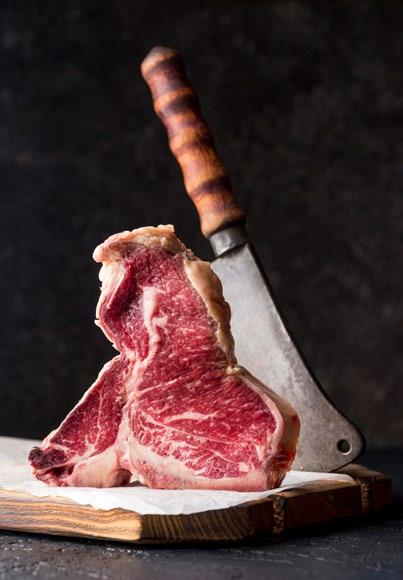
In fact, JOEY Restaurant Group does just this, offering 7oz. CAB sirloin as the base for its JOEY Classic Steak, served with fully loaded crispy mashed potatoes and asparagus ($36.75). This item also offers the choice to upgrade to an 11oz NY Striploin (for an additional $13) or a 7oz. filet mignon (for an additional $18).
Other brands have taken the approach of introducing special events and promotional menus in order to offer beef dishes at more accessible price points while drawing customers to dine onsite. One example is the weekly Prim Rib Dinner special

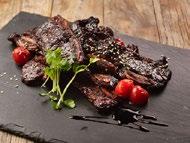

REDUCING IMPACT

A combination of factors is shaping consumers eating and dining habits at an accelerated rate. Canadians are increasingly reducing the amount of animal protein they consume. As the 2023 Nourish Trend Report highlights, consumers are embracing a diet that features a combination of plant and animal proteins — a phenomena dubbed ‘reducatarianism.’
“A diet blending animal and vegetable proteins results in a more affordable household food budget and planetary budget,” explains Jo-Ann McArthur, president of Nourish Food Marketing. “Beef consumption is trending downwards in 2023, therefore it’s important for us to offer different proteins on our menus, including plantbased,” agrees Dave Godfrey, director of Culinary, Firkin Group of Pubs. “Those that want to eat beef will be looking for better quality, sustainably raised, but [are] willing to pay a little more.”
offered at B.C.-based Joseph Richard Group’s (JRG) Townhall restaurants. Townhall Langley offers an 8oz slow-roasted prime-rib meal served with mashed potato, Yorkshire pudding, green beans and gravy after 6 p.m. on Sundays ($24.95 or $30.95 for 10oz).
Townhall locations also offer a $9 Smashburger special (all-beef patty, ketchup, mustard, onion, pickles and American cheese) on Sundays as part of JRG’s ‘Happy Days’ specials program. In a similar vein, Earls restaurants offer $5-off all steaks on Wednesdays as part of its ‘Daily Dine-in Deals’ specials.
JOEY also features a number of beef-focused items on its Happy Hour menu. JOEY Sherway in Toronto features a Sliders Royale Duo ($11.75) or Trio ($16.50), Hand-Pressed Burger ($16.50), Bacon Cheddar Burger ($20) and Steak Frites ($26) as part of Happy Hour.
“As chefs balance price points and the growing demand for culinary exploration, they’re able to embrace creativity,” says Jones. “Chefs today are
16 FOODSERVICE AND HOSPITALITY JULY/AUGUST 2023 FOODSERVICEANDHOSPITALITY.COM
Chop Steakhouse Steak Masters (above)
CONTINUED ON P.20 @FREEPIK.COM
ALBERTA
Gordon Food Service Canada – Calgary
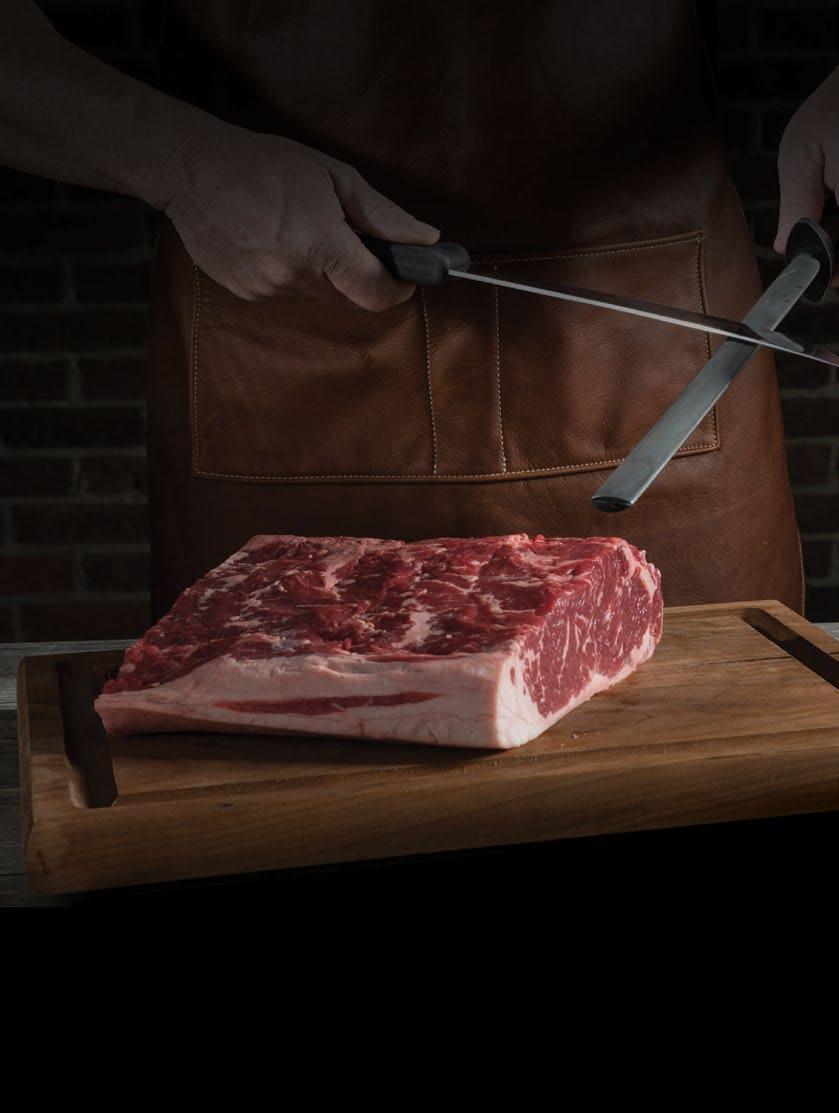
Gordon Food Service Canada – Edmonton
Intercity Packers – Edmonton
BRITISH COLUMBIA
Intercity Packers – Richmond
Gordon Food Service Canada – British Columbia

MANITOBA
Gordon Food Service Canada – Winnipeg

To-Le-Do Foodservice
NEWFOUNDLAND AND LABRADOR
Atlantic Grocery Distributors
NOVA SCOTIA
Gordon Food Service Canada – Atlantic

ONTARIO
Gordon Food Service Canada – Ontario
Intercity Packers – Toronto
Macgregors Meat & Seafood
QUEBEC
Gordon Food Service Canada – Montreal
Gordon Food Service Canada – Quebec
Les Viandes Intercite
Contact your sales representative today. Contactez votre représentant pour en savoir davantage.
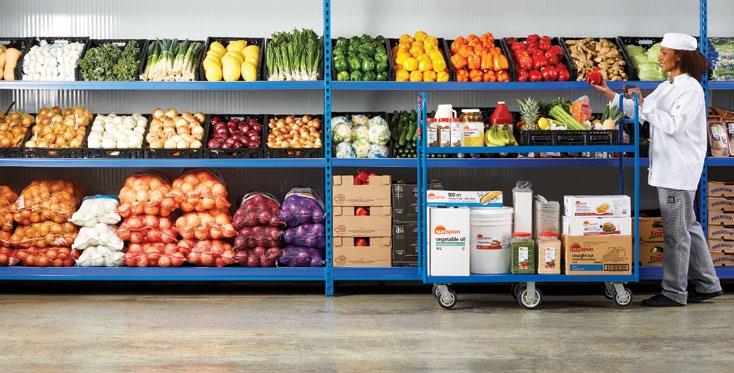


Free Business Membership. No Minimum Order Required. To find a location near you, visit wholesaleclub.ca Follow us @therealcanadianwholesaleclub Save time, shop online.† Place your Wholesale Club order online and pick up in-store. †Applicable fees for in store pickup of online orders are extra. In-store pickup of online orders is only available at select locations and on orders over $75. Why Shop at the Club? • No Membership Fee. • No Minimum Order. • Restaurant Quality Products. • Product sold by the each, Club Pack, case or pallet. • Wholesale pricing and savings through our Multi-unit discounts on thousands of items. ✓ ✓ ✓ ✓ ✓ • Fast check out and efficient store layout to minimize your time away from your business. • Extended opening hours for your convenience. • Commitment to food safety. • Great value on our Sunspun brands, no name and many other private label products. • Focus on your business and leave the shopping to us with PC Express. ✓ ✓ ✓ ✓ ✓
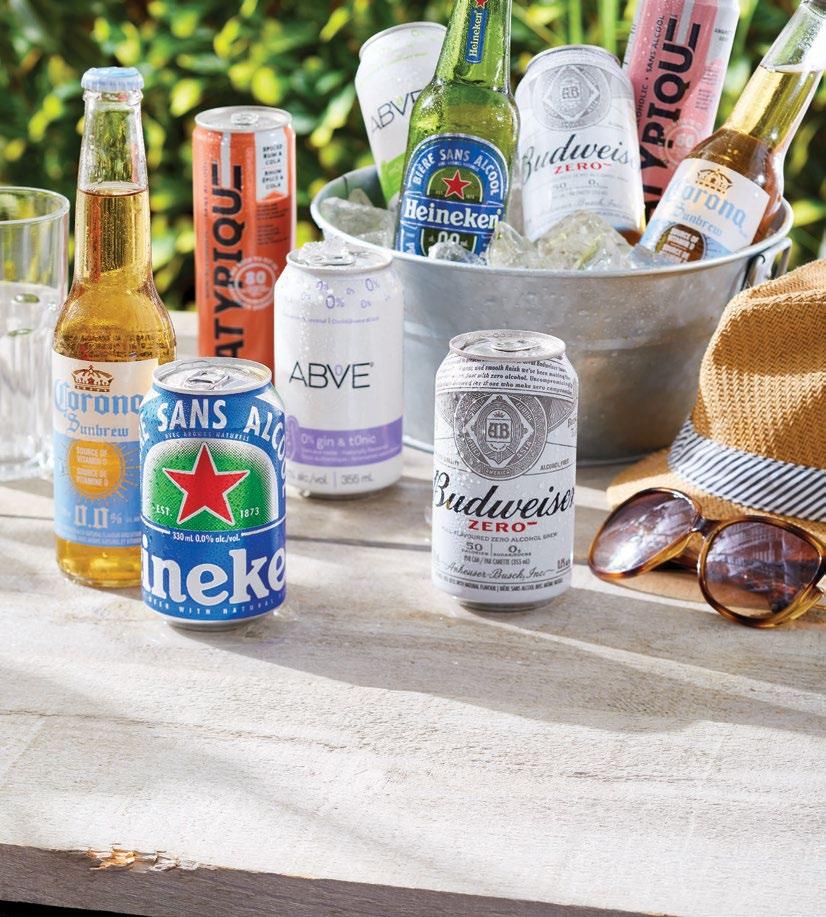

















Available at your local availability may vary by location visit wholesaleclub.ca for store locations, store hours, flyers and more. Atypique non-alcoholic beverages selected varieties 4 x 355 mL Corona Sunbrew non-alcholic beer 6 x 330 mL Above non-alcoholic cocktails selected varieties 4 x 355 mL Budweiser Zero full-flavoured zero alcohol brew 12 x 355 mL Heineken 0.0% alcohol free beer 6 x 330 mL Dive into the ultimate non-alcoholic summer with
becoming more open-minded when it comes to experimenting with different cuts of beef. They do this in order to make beef more cost-effective on their menu or to cater to a wider range of global cuisines, such as Korean cuisine, which makes use of cuts like short rib that are not only more cost-effective than traditional middle meats, like ribeye, strip and filet, but also align well with their dishes.”
This menu innovation also has value beyond creative problem solving. “People are craving exciting tastes and global flavours — things like Indian curries, Korean barbecue, Mexican birria, et cetera,” Godfrey asserts.
And, there is research to support this belief. Technomic’s Ignite menu data points to significant demand for globally influenced flavours. “Among the fastest-growing flavours paired with beef are Lebanese (up 42.1 per cent), sriracha (up 37.5 per cent), Buffalo (up 23.5 per cent), mango (up 20.5 per cent) and Tex-Mex (up 19.2 per cent),” explains Belflower. “Within this list, we once again see those global flavours such as Lebanese and Tex-Mex. There are also spicy, bold flavours being paired with beef, including sriracha and Buffalo.”
Further, carne asada (up 21.1 per cent) has emerged as the fastest-growing beef product on Canadian menus in the last year (Q1 2022 to Q1 2023). “Within this list [of fastestgrowing items], we see some global beef iterations, such as carne asada, as well as more premium types of beef, such as wagyu (up 11.4 per cent),” adds Belflower.
The continued demand for exciting internationally inspired flavours can be seen in menu offering such as Earls’ Bangkok Bowl featuring Thai basil salad, jasmine rice, marinated mushrooms, peanuts and an option of protein, including 3oz. sirloin. Tim Hortons’ recent launch of Chipotle Steak Loaded Wraps and Loaded Bowls also stands as a great example of this trend’s influence.
The 2023 iteration of Chop Steakhouse & Bar’s signature Steak Masters feature menu boasted a range of international flavours, too, all made with 100-per-cent Canadian beef. Featured items included Spicy Beef Bao made with gochujang braised beef, Sous Vide Filet served with beef tallow French fries and a Smoked Sirloin Picanha made with chimichurri.
“Diners want to be wowed by their meal, both the quality and the flavours. Global fusion flavours are taking centrestage and beef eaters are seeking out lesser-known beef cuts for the experience of something new that they can get excited about,” Jones elaborates. “We
absolutely see the industry responding to that by making those traditionally less-popular cuts more readily available. It’s exciting to watch chefs innovate and create such beautiful and thoughtful dishes with our beef.”
Looking beyond the popularity of international flavours, Godfrey points to slower cooking methods as a key beef trend. “Smoking is a great method of preparation and is a popular new flavour,” he explains. “Even methods such as sous vide are being used in more casual restaurants. Both techniques allow for creating great, flavourful dishes out of somewhat cheaper cuts of beef.”
SUSTAINABILITY MATTERS

An extension of diners’ expectations of a quality experience is the expectation that their favourite restaurants’ offerings take sustainability and responsible sourcing into account.
“We know that consumers today are actively seeking high-quality beef, and the Certified Angus Beef brand is the only brand certified for flavour,” notes Jones. “But, that’s the just a starting point. Beef eaters also care about where their beef comes from and how it’s raised.”
“The success of A&W [in Canada] has shown that people care about sustainable/ responsible production of beef,” agrees Godfrey. “Overall, people are much more aware of where their food comes from and how it was raised…and they like to feel good about what they eat.”
And, as University of Guelph professor Mike von Massow explains in the 2023 Nourish Trend Report, when it comes to sustainable meat consumption, “It’s not the cow; it’s the how.”
“Sustainability is now clearly entrenched in the lexicon of Canadian agriculture, shaped by the need to feed a growing domestic and global population on an ever-shrinking land base while finding ways to reduce the environmental impacts of modern farming practices,” says Jo-Ann McArthur, president of Nourish Food Marketing. As an “intriguing” example of this, she notes, “The Canadian Roundtable for Sustainable Beef (CRSP) seeks to encourage production practices that are environmentally sound, socially responsible and economically viable. The result: many QSR chains, including McDonald’s, A&W and Harvey’s, now feature certified sustainable beef on their menus.”
And, as operators work to provide beef
Facing Inflation
Highlighting the severity of inflation’s impact on beef prices, Statistics Canada data for retail prices indicates the price for beef sirloin cuts increased 46.1 per cent between March 2020 and March 2023. Other cuts have also seen steep price increases, with ‘beef stewing cuts’ increasing 20.3 per cent and ‘beef rib cuts’ increasing 13.4 per cent in the same period.

In the face of this ongoing challenge, operators have had to make decisions about the product they’re offering.
“While chefs may be tempted to substitute high-quality beef with lower-quality options or other proteins, historical trends indicate that during times of inflation, supply challenges, or economic uncertainty, consumers who visit restaurants to eat steak are willing to pay more to ensure they enjoy a good-quality steak,” says Cody Jones, vice-president, International, Certified Angus Beef. “Hence, it’s crucial for restaurants to make informed decisions that guarantee high-quality beef cuts and a remarkable dining experience. Restaurants can’t afford to lose a customer over a bad steak.”
offerings that meet guest expectations, effectively telling the story of that beef becomes an important piece of the puzzle.
“As diners seek out exceptional experiences, menus are evolving to not only offer the highest quality, but to tell the story behind the offerings,” Jones explains. “We often see chefs who use the CAB brand include stories — and even photos — on their menus of the Canadian family farmers and ranchers who raise the beef they proudly serve.”
In the face of challenges such as price pressure and economic uncertainty, delivering on guest expectations when they choose to dine out is of paramount importance. “It all comes back to demand for consistent quality and higher dining expectations than ever before,” says Jones. “It starts with the food, but now includes the entire dining experience and how great meals create memories.” FH
20 FOODSERVICE AND HOSPITALITY JULY/AUGUST 2023 FOODSERVICEANDHOSPITALITY.COM
ISTOCKPHOTO.COM VLG
THE OF FUTURE
transformation is underway, offering non-animal-based protein options
BY RIANA TOPAN
Akey question looms on the horizon: how will we feed a growing global population and meet the nutritional needs of more than 10 billion humans in the year 2050, without jeopardizing the well-being of our planet or its inhabitants?
Our current food system is rife with challenges. Since the rise of industrial animal agriculture in the 1950s, food production has become intensive, highly concentrated and unsustainable, negatively impacting public
health, the environment, animal welfare and rural communities. The way we produce protein from animals has become a leading cause of many of the most pressing global problems plaguing society today.
Climate change, anti-microbial resistance and pandemic risk are urgent, existential issues stemming from animal agriculture’s vast resource use, potent Greenhouse Gas (GHG) emissions, deforestation, crowded conditions, and overuse of antibiotics. Compounding these threats are the many ethical issues presented by modern food
production: impacts on public health and nutrition, poor working conditions on farms and in slaughterhouses, widespread industry labour shortages, rising global food insecurity, deadly foodborne illnesses, and the jawdropping slaughter of some 92.2 billion land animals and one to three trillion marine animals annually.
Fortunately, a much-needed transformation is underway, a kind of fourth agricultural revolution in which new technologies are enabling the production of meat, seafood, dairy and eggs without the animal. These

JULY/AUGUST 2023 FOODSERVICE AND HOSPITALITY 21 FOODSERVICEANDHOSPITALITY.COM FOOD TECHNOLOGIES
A
ADOBE STOCK: FREDERIC MOUNIGUET/WIRESTOCK CREATORS
proteins may change the game and put our food systems on the right side of history and the future — by reducing our food’s environmental impact, decreasing public-health risks, and alleviating many of the significant ethical concerns associated with large-scale animal agriculture. Further, they could facilitate protein production at an unprecedented scale.

Foodservice professionals are increasingly familiar with the emerging range of high-fidelity plant-based products that closely resemble their animal-based counterparts, be it veggie burgers that bleed, scrambled eggs made from mung beans, or chicken-nugget analogues nearly indistinguishable from the real thing. New products such as marbled steaks and chewy bacon are expected to appear on grocery store shelves soon, giving consumers (and chefs) delicious new options to experiment with, without the environmental, health or ethical concerns of conventional animal meat.
The evolution of animal-free proteins has advanced in great measure through fermentation and cellular agriculture. Traditional, biomass and/or precision fermentation use microbes to create food products or ingredients that closely resemble animal products, with more realistic tastes and textures than can usually be achieved in plant-based products. Some of these products are already on the market, like animal-free ice cream or animal-free egg proteins that look, taste and function just like dairy ice cream or chicken eggs.
84% of chefs would consider replacing meat with cultivated protein on their menus
In cellular agriculture, cultivated proteins are made by replicating the biological processes that occur on a cellular level when, for example, milk is made by a cow, or an egg is made by a hen. The culturing process typically happens inside a “cultivator,” where cells can be fed and grown to form muscle and connective tissue, similar to the manner in which breweries grow yeast cells to produce beer. The result is a product identical to the meat and animal by products consumed around the world today. Fermentation-enabled, cultivated and plantbased proteins can also be merged to create hybrid products. Replacing conventional animal protein with protein from these alternative sources has enormous benefits. These options are kinder, far less likely to lead to disease outbreaks or foodborne illnesses and could have better nutrient profiles. Plant-based proteins have a much lower carbon footprint and require fewer resources to produce, and projections for the environmental benefits of cultivated proteins are incredibly promising: a 2022 study in Nature Food revealed that replacing animal-source foods in European diets with animal-free proteins could reduce global warming potential, water use and land use by more than 80 per cent.
Cultivated meat products are not widely available commercially, though it is only a matter of time. Singapore is the only country where cultivated meat products are already being sold. However, the U.S. government recently determined that cultivated chicken products from two California-based startups are safe to consume, paving the way for these products to be sold to consumers. Canada is expected to follow suit.
The meat industry’s substantial investments in animalfree proteins are a strong indicator of future growth. Just as

automakers have embraced the electric vehicle, the world’s leading meat companies are diversifying their product portfolios. Half of the 60 largest global meat, dairy, and seafood companies tracked in the The Coller FAIRR Protein Producer Index are investing in the alternative protein market. As a former CEO of Tyson Foods, the second-largest processor and marketer of chicken, pork, and beef worldwide, said in 2018: “If we can grow the meat without the animal, why wouldn’t we?”
Cultivated meat is expected to become available in retail within the next two to three years, offering the food industry a more sustainable and ethical alternative source of protein that can replace conventional meat at a 1:1 ratio. Chefs are ready to embrace these options. In fact, SuperMeat reported that in a 2022 survey, “Seventy-seven per cent of chefs would be willing to pay a premium for cultivated meats and poultry due to its benefits, most importantly food safety and environmental friendliness”. The overwhelming majority — 84 per cent of chefs — would consider replacing meat with cultivated protein on their menus, if pricing is similar.
The foodservice industry is already changing. Plant-based menu items have increased by more than 60 per cent in just the last four years, and experts predict that plant-based items will find a place on more than 40 per cent of restaurant menus by 2025. Dozens of companies and campuses are reducing the amount of meat they serve for environmental and animal welfare reasons, and health-care facilities are shifting to plant-forward menus to improve the health of their patients, staff and visitors.
As technologies evolve and the range of animal-free proteins expands, the possibilities for industry will be endless. This is truly the future of food, and I can’t wait to taste it. FH
22 FOODSERVICE AND HOSPITALITY JULY/AUGUST 2023 FOODSERVICEANDHOSPITALITY.COM
ISTOCKPHOTO.COM/ALEXANDER TRAKSEL
Riana Topan runs Humane Society International/ Canada’s Forward Food program, helping institutions across Canada increase their offerings of animal-free food options – free of charge
I N I N G
C A NADiAn A TIMELINE OF HOSPITALITY “FIRSTS" FOR
PUBS, TAVERNS & RESTAURANTS
CONTRIBUTED BY BY JEFF STEWART
In honour of the 20th anniversary of Food Day Canada, founded by the late Anita Stewart in 2003, F&H is proud to present this timeline of Canadian hospitality milestones in partnership with Food Day Canada. Agriculture and preferences change over time, but in Canada it seems that immigration is fuelling the evolution of what we eat. Dining out is often the first bridge between unfamiliar cultures where we experience new foods. This timeline is far from exhaustive, but highlights some of the rich history of the Canadian experience. Some of the businesses highlighted are still in operation.
Over the last three decades, much has happened and while it's challenging to capture it all, it's worth highlighting that in 2003, many chefs and restaurants banded together to start a movement known as Food Day Canada that continues today almost 20 years later.
The evolution of a national identity for Canadian cuisine is a moving target. With immigration comes new foods yet in some cases ensconces older traditions. Our rich and storied past is that of the people, the land, and our shared dining experiences.
JULY/AUGUST 2023 FOODSERVICE AND HOSPITALITY 23 FOODSERVICEANDHOSPITALITY.COM SLUG HERE
D
1606

At the height of the cold in 1606-'07, Champlain proposed a social club, “The Order of Good Cheer," to keep spirits up. The Mi'kmaq supplied most of the fresh food.
1754
AUBERGE SAINT-GABRIEL MONTREAL
The auberge was built in 1688 by a French soldier, then operated as the first “auberge" for Lower Canada, starting in 1754. The building was turned into a townhouse in the 1800s but returned to its original vocation in 1914.
1793
THE OLD ANGEL INN NEWARK, ONT.
The Old Angel was founded as “The Harmonious Coach House" on land granted in 1789. Newark became the first capital of Upper Canada, now Niagaraon-the-Lake, Ont.
1838
ELDER’S SHOP CONFECTIONARY KINGSTON, ONT.
One of the first owned businesses Kingston was confectionary. municipal tax for Kingston lists Maria Elder as in 1838. In 1844, Saloon, also run couple, would luxury that the affords” with seafood, southern confectionery, finest liquors
1749
THE SPLIT CROW, HALIFAX
Historically, this is the first tavern license recorded in Canada. Although no longer in the original location, for a time, this bar was called the “Spread Eagle” and was popular among sailors.
1756

Originally from Guinea, Marie Marguerite Rose was released after being enslaved for 19 years. Once freed, she married Jean Laurent, a Mi’kmaq man. The couple ran an inn and tavern. According to historical record, she is the first free black businesswoman in Canada.
1837
1849
WHEATSHEAF TORONTO
MONTGOMERY'S
TAVERN TORONTO
Montgomery's Tavern was the headquarters of William Lyon Mackenzie, leader of the Upper Canada Rebellion. Although the 1837 uprising was unsuccessful, it did contribute to Canada's responsible government.
Situated corner of Bathurst, tavern still its character. original its original WheatSheaf in history regular stationed
24 FOODSERVICE AND HOSPITALITY JULY/AUGUST 2023 FOODSERVICEANDHOSPITALITY.COM
ROSE & LAURENT TAVERN LOUISBOURG, N.S.
first blackbusinesses in was a shop and confectionary. The first tax assessment lists James and as shopkeepers 1844, the Oregon run by the would supply “every the market fresh oysters, southern fruits, confectionery, and the and wines.
1856

SIX MILE PUB VICTORIA, B.C.
The oldest pub in B.C. still operates today and was a port of call for sailors and British "tars" from nearby Esquimalt naval base. It was a hub of the small community when stage coaches began to run in the 1880s.
1869
APPLES AND CAKE MONTREAL
This wasn’t a bakery or grocer, it was a safe space for socializing amongst gay men of the time. Apples and Cake, Canada’s first “gay bar,” is also regarded as North America’s first openly gay place of business.
1894
THE WILNO TAVERN WILNO, ONT.
Eastern Europeans arriving to farm the Prairies had an indelible impact on Canadian food, including perogies. While working on the railroad, Ignancy Slominski and his young family opened a restaurant in Wilno where the pierogi are still on the menu.

1849
WHEATSHEAF
TORONTO
1860
TAVERN
Situated at the of King and Bathurst, this historic still retains character. In the location under original name, The WheatSheaf is steeped history and was the for soldiers stationed at Fort York.
GREAT WESTERN HOTEL HEIDELBERG, ONT.
Henry Miller (nee Heinrich Adam Müller) built the Great Western Hotel in a strong German Mennonite community. It still operates as the Heidelberg Inn. Nearby Berlin changed names in 1916 at the outset of ”the Great War” and has been known as Kitchener ever since.
1886
A. SANFT KOSHER MEAT MONTREAL
The various claims for the creation of "Montreal smoked meat" all point to Eastern Europe Jewish immigrants from. Aaron Sanft founded Montreal's first kosher butcher and was first to advertise


CANADIAN PACIFIC HOTELS
“If you can’t export the scenery, we’ll import the tourists,” said Sir William Cornelius Van Horne, founder of Canadian Pacific Hotel. Who went on to build Mount Stephen House in the Rocky Mountains, the first luxury wilderness resort for what would become Canadian Pacific Hotels (now Fairmont).
JULY/AUGUST 2023 FOODSERVICE AND HOSPITALITY 25 FOODSERVICEANDHOSPITALITY.COM 1838 SHOP & CONFECTIONARY
ONT.
1896
JOE LADUE'S HOUSE DAWSON CITY, YUKON
After gold was found in Bonanza Creek, Dawson City went from a mining camp in the swamp to the largest city in Canada west of Winnipeg. Dawson City, founded by Joe Ladue, had its first Gold Rush saloon of many in his private residence.

1916
THE ONLY SEAFOOD VANCOUVER

Greek immigrants, Nick Thodos and Antonio Demetry opened the “only seafood" restaurant, serving fish as fresh as can be, never more than a day old.
1927
THE WOODSTOCK PUBLIC HOUSE, PARADISE, N.L.
Mrs. Emile St. John opened the original Woodstock Tea Room and guest house in 1927. Although the Woodstock has changed hands many times, it has preserved a way of life centred

1937
THE WILDCAT YELLOWKNIFE,
Built in 1937 by and Smokey the help of family, Wildcat Café permanent restaurant Yellowknife and good meals for Currently, it operates seasonally as restaurant.
1901
CHINATOWN CAFÉS TORONTO

MONTREAL BAGEL BAKERY MONTREAL
1928
In 1919, Isadore Shlafman opened the first bagel bakery in Montreal, located just off of SaintLawrence Boulevard where Montrealers got their first taste of hand-rolled woodfired baked bagels.

Long before Nat Bailey 1918 Model-T mobile — a food its time. From location on White Spot Vancouver affordable
WHITE SPOT, Sing Tom opened Toronto’s first Chinese café in 1901. By 1912, there were 19 Chinese restaurants. In the decade that followed, that total grew to 100 units. By the 1950s, restaurants such as Sai Woo, operated by restaurateur Norman Chin, flourished. Chinese immigrants helped build the Canadian National Railroad. The railway brought great economic opportunity for Canada. On the west coast, both Victoria and Vancouver had bustling Chinese neighbourhoods by the early 1900s with Vancouver’s Chinatown outpacing Victoria.
26 FOODSERVICE AND HOSPITALITY JULY/AUGUST 2023 FOODSERVICEANDHOSPITALITY.COM
WILDCAT CAFÉ YELLOWKNIFE, N.W.T.
by Willie Wylie
Stout with family, The was the first restaurant in and served for a dollar. operates as a summer

RETURN OF THE POTLATCH, B.C.
The potlatches of the northwest coast were an intricate way of distributing wealth. The feast and celebrations went on for days to honour the bounty of the land and ocean. However, the system was so foreign to the way of thinking of the Canadian government officials banned the potlatch from 1884 to 1951.
1955
HY’S STEAKHOUSE & COCKTAIL BAR EDMONTON
In the early ’50s, friends of Hy Aisenstat opened one of Alberta’s first full-service steakhouses called The Steak Loft, in Edmonton. Hy saw an opportunity in Calgary’s
1957
CAFÉ IDEAL WARWICK, QUE.
The combination of fries, curds and gravy in rural Quebec started to appear on menus in the late 1950s. Fernand Lachance of Café Ideal in Warwick, claims he first added curds to fries in 1957 when a regular customer

SPOT, VANCOUVER
before it was trendy, Bailey modified his Model-T into a lunch counter food truck before From the first on Granville Street, Spot remains a Vancouver favourite for family dining.
PIZZERIA NAPOLETANA MONTREAL
There is contention about who first brought pizza to Canada. Post-World War II, Montreal, Toronto, even Windsor, Ont., all claim this food. What we do know is the first Pizzeria
Napoletana opened in Montreal in 1948. Starting in the late 1950s, the first pizza ovens started entering the country and gained popularity throughout the 1960s.
Canada began operations in Winnipeg, opening its first freestanding drivein restaurant in 1956. By 1966, A&W Food Services
first Mexican to join the CFL. Following his retirement from football, Primo opened up Primo’s Mexican Grill, B.C.’s first Mexican restaurant.

FOODSERVICEANDHOSPITALITY.COM
1948
1928
1951
JULY/AUGUST 2023 FOODSERVICE AND HOSPITALITY 27
1964
TIM HORTONS

HAMILTON, ONT.
The first Tim Hortons restaurant opened in Hamilton, Ont. in 1964, creating an empire of coffee, doughnuts and timbits. Now, as Canada's largest restaurant chain, "Tim's" serves more than five million cups of coffee daily.

1970
Arriving from Bombay in 1967, Amar Patel was a trained nurse. Through a chance meeting over disappointingly inauthentic Indian food, Patel began to train many up and coming Toronto chefs in traditional Indian cooking including at The Hyatt, The up-andcoming Bombay Bicycle Club and Four Seasons. By 1970, she opened her Indian Rice Factory which remained in business for over 40 years
1978
TOJO'S, VANCOUVER
While you will never see this on a traditional menu in Japan, by many accounts, Chef Hidekazu Tojo did invent the Tojo Roll. The Tojo Roll was created by artfully combining what was available and what people in his restaurant wanted to eat. The Tojo Crab & Avocado Roll (CA) transcended into is now ubiquitous and called the "California Roll", a Canadian invention.
1978
KOREAN VILLAGE TORONTO
South Korean immigration to began to grow in the late 1960s and by 1978 Korean Village Restaurant on strip of the Annex that has since officially been named as Toronto's Koreatown. Ok Re Lee Ke Hang Lee immigrated to Canada and had opened a traditional Korean BBQ restaurant in Toronto. Son Jason is continuing the family legacy.

1979
SOOKE HARBOUR HOUSE SOOKE, B.C.
To celebrate the opening of the new restaurant, Marco’s, at the Calgary Inn, a mixologist named Walter Chell was inspired by his favourite Italian dish, spaghetti vongole. The resulting clam and tomato concoction is now a Canadian standard, the "Bloody Caesar."

Peter Gamoulakos came to Canada in the 1950s and ran a pizza shop in the early ‘70s called Velos. In 1973, he vacationed in Greece, which inspired him to bring this "new" food back home. A pizza shop in Bedford would be the birthplace of what we now know as the Halifax Gyro.
1979 L’EAU À LA BOUCHE SAINTE-ADÈLE, QUE.
This was a serendipitous year for fine dining.
Desjardins and Pierre Audette's Laurentian restaurant, L’eau à la bouche, was founded and eventually into a Relais & Châteaux culinary destination.
west, Sooke Harbour House opened with Sinclair Frederique Philip's menu sourced locally from ocean, forests, and farms. We saw the arrival Scaramouche, featuring chefs Michael Stadtländer Jamie Kennedy. Visionary chefs followed including Bay Fortune, Langdon Hall, Wickaninnish Inn, Auberge du Pommier, and Fogo Island Inn for become a collective of Canadian culinary visionaries leading a focus on local, seasonal conscientious
28 FOODSERVICE AND HOSPITALITY JULY/AUGUST 2023 FOODSERVICEANDHOSPITALITY.COM
INDIA RICE FACTORY TORONTO
began 1960s a that been and immigrated restaurant Lee family
QUEEN OF SHEBA TORONTO & ADDIS MONTREAL
1985
KENSINGTON PATTY PALACE, TORONTO
Popularized in urban centres with the arrival of immigrants from the Caribbean in the '60s and '70s, the Jamaican Patty became the center of a bizarre controversy. At the center of this controversy was Michael Davidson, the manager of his family's bakery, Kensington Patty Palace. The outcome was that the shop owners and restauranteur were permitted to call their meat filled pastry a “Jamaican Patty” to prevent authorities from being confused about this delicious hand-held staple from the islands.

1992
CULINARY OLYMPICS FRANKFURT, GERMANY
In 1992, Canada was represented at the prestigious Culinary Olympics by its first Indigenous team. The team consisted of David Wolfman, Arnold Olson, Andrew George, Brian Sappier and Bertha Skye. The team brought home seven Gold, two Silver and two Bronze medals, including a Grand Gold for Bertha Skye’s
2003
In 2003, Canadian farmers were financially devastated by the BSE Crisis. Chefs across Canada banded together and encouraged everyone to put Canadian Beef on the BBQ in a oneday event that would evolve into so much more than beef, now Food Day Canada.
1984
BOUCHE QUE.
Anne restaurant, eventually grew destination. Out Sinclair and from gardens, arrival of Stadtländer and including Inn at River Café, for what has visionaries conscientious menus.
MARROUSH SHAWARMA, OTTAWA
1986
CAFÉ CHAU VANCOUVER
The political turmoil from the Vietnam War brought an influx of immigrants to our shores and a whole new cuisine to Canada. Café Chau began as soup stall in a refugee camp in Indonesia. The Huynh family escaped Vietnam and lived at the refugee camp for two years before moving to Canada.
Co Chau opened the Vancouver's first Vietnamese deli in 1986.
1993
ON THE TWENTY JORDAN, ONT.
Legislation prevented food from being served at a place where alcohol is produced until the early 1990s. Thanks to Canadian wine pioneers Donald Ziraldo and Karl Kaiser, the wine industry was booming. With wine and culinary tourism now taking off, in 1993 Amendments were made allowing a winery to also have a restaurant on premise. The Pennachetti family opened On the Twenty at Cave Spring Cellars in Jordan, Ontario and was the first winery restaurant in Canada.
JULY/AUGUST 2023 FOODSERVICE AND HOSPITALITY 29
FOODSERVICEANDHOSPITALITY.COM
Ottawa has a unique title of being the shawarma capital of Canada with 200 or more shawarma restaurants in our Capital city. A 24-year old, Moustafa al Hajjar opened the first shawarma shop in Ottawa on Elgin Street in 1984 called Marroush. 1983
The first Ethiopian restaurants in Canada both opened the same year, 1983, in Toronto and Montreal. In Toronto, the community on the Danforth has unofficially become known as Little Ethiopia, a community favourite for injera sharing platters.
WORLD'S LONGEST BBQ NATIONALLY
WE BRING FOOD TO LIFE
Local restaurants are at the heart of our communities. Catering to small businesses, we are your partner in foodservice. With unparalleled product assortment, trusted expertise and innovation, we are ready when you are.

Learn about our People, Products & Platforms.

Visit Sysco.ca
Chefs Michael Caballo and Tobey Nemeth
The husbandand-wife duo behind Edulis have gained a devoted following
BY NICOLE DI TOMASSO
Tucked away on Niagara Street in Toronto, just off bustling King Street West, sits Edulis, a small old-fashioned restaurant known for its European-inspired seasonal tasting menu created by husband-andwife owners Michael Caballo and Tobey Nemeth. Last year, Edulis was awarded One Star as part of the inaugural MICHELIN Guide Toronto launch, making it one of the first Michelinstarred restaurants in Canada.
Hailing from Edmonton, Caballo attended culinary school at the Northern Alberta Institute of Technology (NAIT) and worked in a couple of kitchens before moving to Toronto. Nemeth, on the other hand, attended culinary school at George Brown College and spent the first of couple of years after graduation working in various restaurants before landing her first serious cooking job at now-shuttered Avalon Restaurant in Toronto. It was there she met Caballo.
Eventually, the couple married and embarked on a four-year culinary journey, starting in Spain to explore
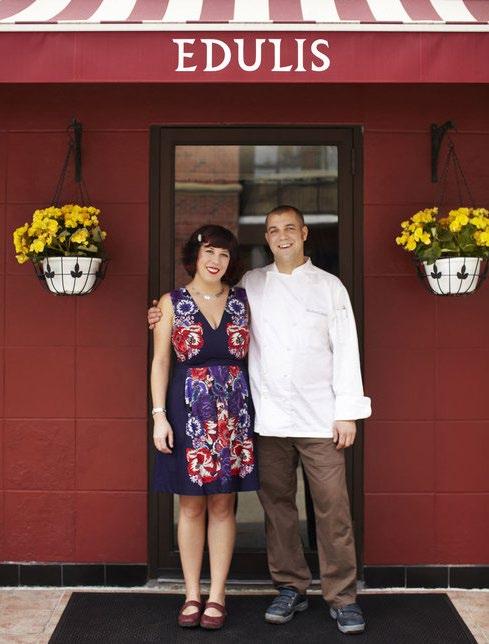
JULY/AUGUST 2023 FOODSERVICE AND HOSPITALITY 31 FOODSERVICEANDHOSPITALITY.COM
Edulis, Toronto
Caballo’s family heritage. They also worked in remote Haida Gwaii (the Queen Charlotte Islands); in Vancouver during the Olympics; in the Chianti countryside in Italy; and in Panama as part of an opening team for a hotel and restaurant. In Panama, while debating their return to Toronto, Caballo and Nemeth received a message from a friend who had heard Anton Potvin, owner of Niagara Street Café (now Edulis), was considering selling, marking a moment that changed their lives forever.
“Previously, Michael was the chef at Niagara Street Café and it was also a restaurant I had been going to for more than 20 years with my girlfriends,” says Nemeth. “It has always been my dream restaurant. It’s the perfect size and tucked away on a side street, which makes it feel like a secret.”
Since its opening in 2012, Edulis has gained critical acclaim. In addition to its Michelin-star rating, Caballo and Nemeth were also the MICHELIN Guide Toronto 2022 Service Award winners. Most recently, Edulis was ranked number four in Canada’s 100 Best Restaurants for 2023.
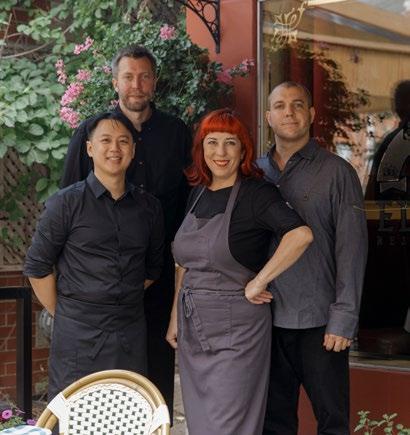
“Michael and I, as well as Brett Healey and Philip Shaw, our front-of-house staff, have the hospitality gene in our DNA. We genuinely love what we do, and it’s a great feeling to be recognized for that,” says Nemeth. “We’re not a restaurant for everybody; we’re kind of hard to find, we don’t provide a menu ahead of time and we’re a no-tipping restaurant with prepaid reservations.”
The name, Edulis, translates to edible in Latin and is also linked to one of the finest mushrooms, boletus edulis (also known as porcini mushrooms), and is featured as the restaurant’s logo. With seating for roughly 24 diners, the restaurant offers
dinner service ($200 per person) from Thursday to Saturday and lunch service ($100 per person) on Sunday. Its multi-course set menu showcases the best ingredients of the moment, with an emphasis on mushrooms, seafood and vegetables.
“We have an affinity for mushrooms,” says Caballo. “I’ve always been a mushroom nerd. In the past, I was a big mushroom forager, so I always liked the idea of bringing that back to the restaurant.”
“We cook naturally with what we have – no sous vides or modern techniques. We’re open to learning about those things, but we gravitate towards a slowness. Everything is laborious

and careful and we enjoy that process,” says Nemeth. “We encourage our guests to put their phones away and lose themselves in time.”
While some ingredients are supplied from overseas, Caballo and Nemeth also work closely with a small group of Canadian suppliers, including Toronto-based Hooked Inc., Newfoundland-based Foggy Shoals Fish Co., Fort Erie, Ont.-based Blue Goose Farm and Hamilton, Ont.-based The Packing House Inc. This summer, white asparagus, porcini mushrooms and
spot prawns are a few ingredients guests can expect to try.
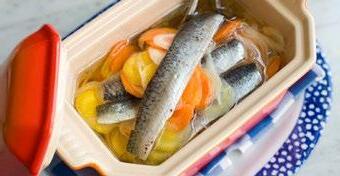
“[We have deep, meaningful relationships] with everyone who’s involved in what we do at Edulis. We work with small farms and fishing companies and let them do what they do best. In turn, it gives us the freedom and inspiration to do what we do best. We like to be at the ground level with those things,” says Caballo.
Interestingly, Caballo and Nemeth avoid using buzzwords such as sustainability, local sourcing or slow-food movement. They say establishing and maintaining relationships with farmers, foragers and fishers is most important.
“We don’t have the power to make sweeping changes in
the industry, as much as we’d love to see those changes. We simply have to do what’s right for ourselves,” says Nemeth. “We’ve worked as cooks for a long time and witnessed a lot of imbalances within the industry that have frustrated us over the years. Suddenly, you realize that you’re in a position to do things better yourself, which is such a relief.”
For aspiring chefs looking to break into the industry, the husband-and-wife team offers a slice of advice:
“Read, read, read,” says Nemeth. “Have respect for this industry and spend every dime you can on eating out and travelling wherever you can, whenever you can.”
“Be patient with your career. Put in the hours and the work and don’t be in such a rush,” says Caballo. “Take the time to develop yourself personally and professionally. These days, that’s hard advice to follow, because everyone craves immediacy. FH
32 FOODSERVICE AND HOSPITALITY JULY/AUGUST 2023 FOODSERVICEANDHOSPITALITY.COM
(clockwise) Brett Healey; Philip Shaw; Tobey Nemeth and Michael Caballo
PHOTO CREDIT JENNA WAKANI







































No Prep Needed! Serve Individually Wrapped THE NEXT BIG SNACKING SOLUTION 7 in 10 Canadians snack at least once a day!* Smucker’s® Uncrustables® PB&J sandwiches are the perfect convenient snack or part of a meal time solution. Just refrigerate and serve! *Source: Technomic 2022 Canadian Snacking Occasion Consumer Trend Report For more information, contact your Smucker Away From Home Sales Representative or visit our website at www.smuckerawayfromhome.ca ©/® The J.M. Smucker Company and its Subsidiaries. Now Available in Canada
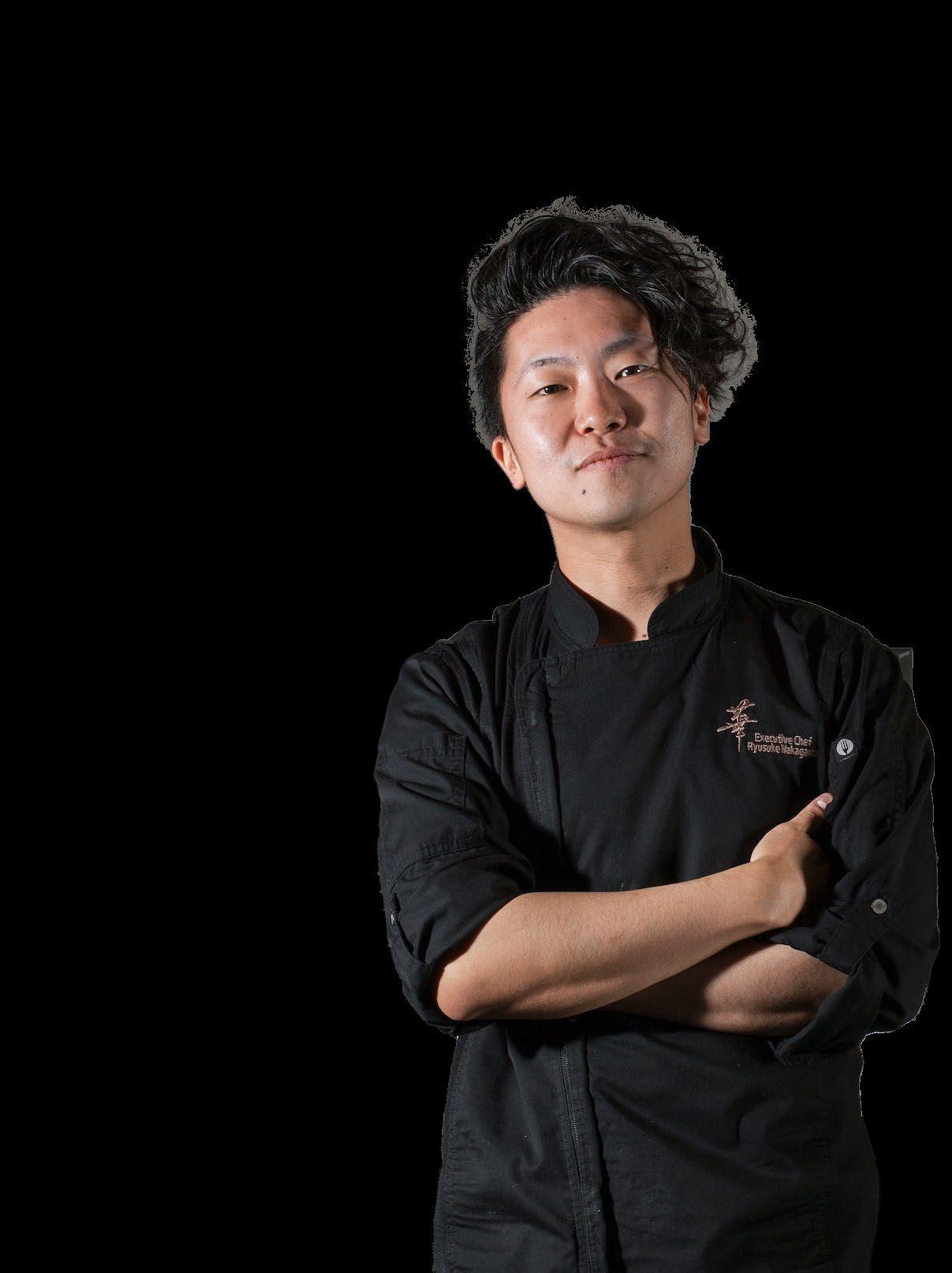
FOODSERVICEANDHOSPITALITY.COM

As the chef at the helm of Canada’s only Michelin two-star restaurant, chef Masaki Saito has a good deal of clout associated with his name — especially given that the restaurant in question bears his name.
Sushi Masaki Saito, situated in Toronto’s upscale Yorkville neighbourhood, has been collecting accolades since its opening in 2019. In its first year, it ranked 10th on the Canada’s 100 Best Restaurants
Chef Masaki
BY DANIELLE
list and received the coveted title of Best New Restaurant.
The restaurant stands out in the Toronto dining scene, thanks to its emphasis on edomae-style sushi, intimate atmosphere and commitment to Omotenashi — the Japanese practice of mindful hospitality. The omakase-style experience features exclusively line-caught fish and seafood sourced directly from Japan.
“[Edomae] is a very traditional and authentic style sushi,” says Saito, explaining the sushi common in North America is
a simplified, modernized take on sushi. In traditional edomae style, the fish is aged or cured to enhance flavour and texture. And, chef Saito characterizes the fare served up at his eponymous restaurant as: “edomae style, with my [added] colour.”
Commanding a per-head price of $680, chef Saito has fine-tuned every detail to ensure the ultimate dining experience. The restaurant’s internal culture has been built on providing the highest level of experience and ensuring all details can be
attentively seen to.
For this reason, Sushi Masaki Saito only serves about 11 guests per night (in two seatings). It’s also the reason the restaurant is only open five nights a week, closes any time the Japanese fish markets are closed (for holidays), and does not open if the chef is feeling under the weather.
“We don’t serve our customers without the presence of Masaki Saito [or] the best ingredients that we can provide,” elaborates Jonathan Tang, the restaurant’s general manager. “We respect the
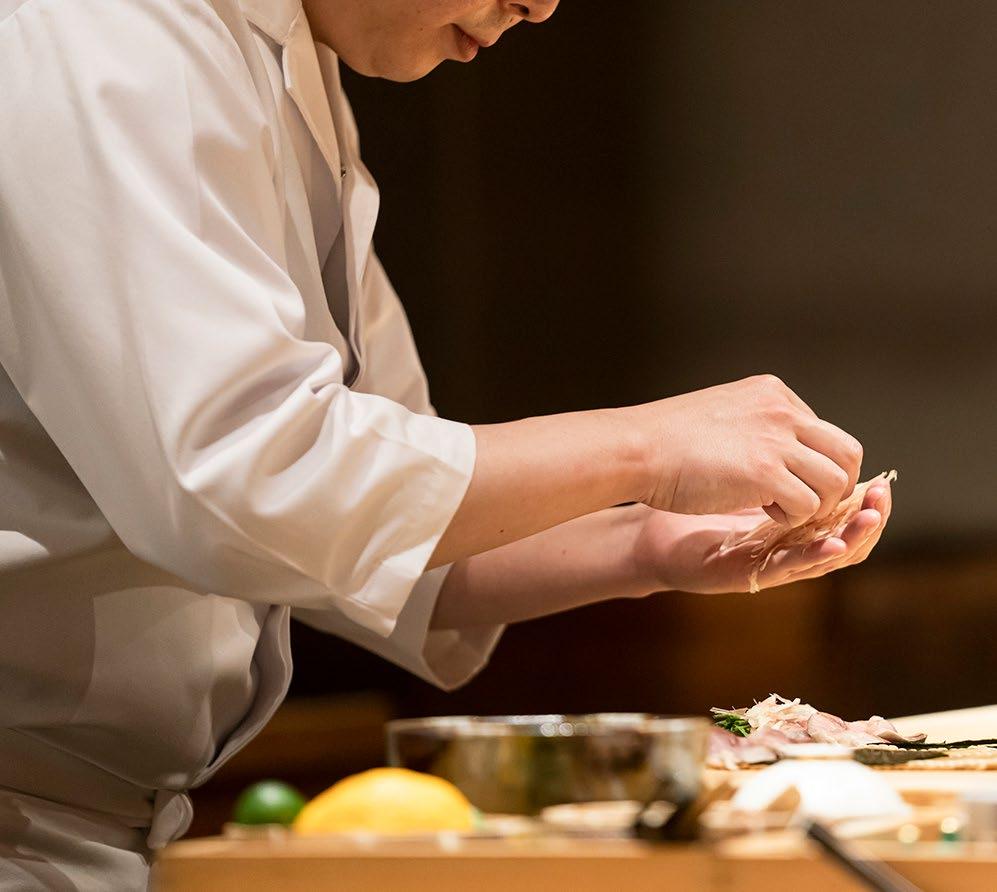
36 FOODSERVICE AND HOSPITALITY JULY/AUGUST 2023 FOODSERVICEANDHOSPITALITY.COM
Sushi Masaki Chef building turning into
EDISON SIGUA (PLACENEWINC)
Masaki Saito
Masaki Saito, Toronto
chef’s decision to deliver only the best to his customers…Chef always focuses on quality first, and if he cannot get the best ingredients, we don’t open our restaurant.”
And, chef Saito notes, it’s exactly this level of commitment to quality and intense focus on refining every detail that he believes earned him his two-star Michelin rating in Canada.
The road that has led the chef to this stage in his career is remarkable in itself. Saito’s passion for sushi developed at

a young age, inspired by his experiences eating at the sushi bar of the restaurant his family frequented while growing up in his native Hokkaido, Japan. But the formative memory that ultimately inspired his career was realizing just how special — how skillful — that particular sushi chef was.
“That sushi chef died of cancer, then of course, we couldn’t go to [that favourite] restaurant anymore…Even at seven/eight years old, I [recognized] that sushi restaurant was better

than the new ones we tried,” he explains. “That chef became my target. When I was eight/nine years old, I decided I [would] be a sushi chef.”
This passion and goal led him to pursue an education in marine biology. Rather than attending a traditional high school, Saito took part in a threeyear program that taught him about catching, caring for and preparing seafood — including hands-on experience line catching tuna.
He went on to train in Tokyo, where he learned the art of the edomae style from sushi masters. This period of his career also greatly informed the chef’s understanding of and commitment to customer care, plating and care for the fish and ingredients used.
Saito then moved to New York, where he helped open the NYC location of Sushi Ginza Onodera. Here he earned significant acclaim and recognition —
receiving his first Michelin star in 2017 and gaining a two-star rating in 2018 (at age 30).
Saito’s interest in Toronto was sparked by his now business partner, restaurateur William Cheng (Shoushin). The chef spent time experiencing the Toronto dining scene and saw an opportunity to contribute to the ever-rising calibre of restaurants in Toronto.
In the future, Saito says he expects to see “many chefs and many restaurants coming to Toronto, Vancouver and Canada from other countries.” And, now that the Michelin Guide has come to Canada, Saito expects to see the number of highcalibre restaurants in the country grow, fostering the opportunity to attract an inflow of culinary tourism. Looking ahead, chef Saito says he hopes to open additional restaurant concepts in Toronto — including those at a more accessible price point. “I want to share my skill [and], of course, the Japanese culture,” he explains. “I want to share; I want to teach.”
In fact, work is already underway to launch a new iteration of Sushi Masaki Saito’s sister restaurant Tachi — a unique stand-up omakase concept, which recently ended its years-long stint at the downtownToronto food hall, Chefs Hall.
Saito notes that it’s difficult to be precise with opening dates, but the next iteration of Tachi is expected to open later this year.
When asked what advice he would give to young people entering the restaurant industry, Saito said: “Passion, energy and respect. Respect is very important. Chefs have to have respect for [their ingredients]; [also] the customers and chefs to each other and chefs to chefs.” FH
JULY/AUGUST 2023 FOODSERVICE AND HOSPITALITY 37 FOODSERVICEANDHOSPITALITY.COM
Chef Masaki Saito is building a legacy by turning his passion refined creations
DANIELLE SCHALK
Care, knowledge and passion
A vibrant history and bright future for the Canadian egg
This year marks a special year for egg farmers across the country as we celebrate Egg Farmers of Canada’s 50th anniversary.
As an egg farmer myself, I know that behind every egg is a story of care, knowledge and passion. So, as Egg Farmers of Canada celebrates this important milestone, I wanted to share with you some of the efforts we’ve enacted to make sure that our world-class farming standards, commitment to sustainability and connections to our local communities remain a top priority.
At the heart of these efforts is collaboration. We work closely with animal welfare experts, veterinarians, scientists, government and supply chain stakeholders to develop industry standards and practices that all Canadian egg farmers follow, such as our national Animal Care Program and Start Clean-Stay Clean® food safety program. We’re constantly looking for ways to evolve these programs, leveraging the latest tech developments, scientific discoveries, and understandings about animal welfare. Backed by Egg Quality Assurance™, a certification program that visually shows Canadians their eggs are produced by Canadian farmers and meet rigorous standards, Canada’s egg farming practices are among the best in the world.
across the country who are producing a well-loved kitchen staple as their passion—some of whom have grown up in farming families, and others are embracing a new future in the sector.
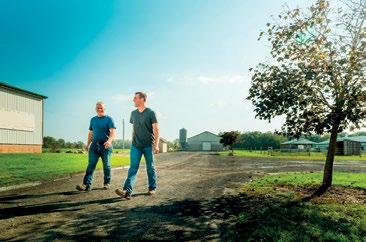
Our 50th anniversary
at what’s ahead.
You can see how Canada’s egg farmers inspire each other to embrace sustainable farming practices and work toward collective goals. Another great example of this is our commitment to phasing out conventional cages and moving to alternative methods of production. And we’re making substantial, real progress in that regard and in our commitment to provide the millions of Canadians who rely on eggs every day with incredible choices in the range of eggs available to them for purchase.
Because of the coordination and commitment of our farmers, we’re set to achieve our goals ahead of schedule. No other country could transform its egg production this broadly and quickly. That’s something to be proud of.
Our 50th anniversary doesn’t just provide an opportunity to reflect on the vibrant history of Canadian egg farming. It’s a chance to look at what’s ahead.


Producing high-quality eggs is about more than regulations, though. The reason why our industry is strong is because of the commitment of the hardworking people behind it.
Just as importantly, our egg farmers will continue to be your neighbours, community members, and fellow Canadians in the years ahead, and we’ll never stop working to deliver the eggs that you love. Thank you to the millions of Canadians who support and enjoy Canadian eggs. Without you, and our farmers, we wouldn’t be celebrating this exciting milestone. Here’s to another great 50 years!
Sincerely,

Producing high-quality eggs is about more than regulations, though. The reason why our industry is strong is because of the commitment of the hardworking people behind it. There are over 1,200 egg farmers
Embarking on the next 50 years, there’s even more to celebrate. We’ve got our sights set on new research, innovation and technical advancements to support more sustainable agricultural practices and a collective goal of working towards net-zero greenhouse gas emissions by 2050.
Roger Pelissero
doesn’t just provide an opportunity to reflect on the vibrant history of Canadian egg farming. It’s a chance to look
ADVERTORIAL
Roger Pelissero is a third generation egg farmer from Ontario and Chair of Egg Farmers of Canada. Visit eggfarmers.ca to learn more about egg farming in Canada.
AnnaLena, one of Vancouver’s eight named Michelin Star restaurants, is located in Kitsilano Beach, a short walk from downtown Vancouver.
Consistently named as one of the 100 Best Restaurants in Canada and featured in En Route Magazine as one of the Top 10 New Restaurants upon opening in 2015, it is co-owned by chef Mike Robbins and Operations manager Jeff Parr.
The restaurant was named after Robbins’ two grandmothers. “Anna was always the host of the party and loved to drink and socialize so the bar area is inspired by her. Lena was the soul of the family and she loved to cook. My first memory of food came from her so the kitchen is inspired by her,” he explains.
AnnaLena is a true reflection of Robbins’ unique life journey, passions and collections. “My food is a marriage of my multicultural upbringing in the East side of Vancouver and the cooking techniques I learned as an adult,”
Chef Mike Robbins
AnnaLena, Vancouver
AnnaLena’s unique journey earns it a Michelin Star
BY MORAG MCKENZIE
says Robbins, whose menu puts a creative and innovative spin on West Coast Canadian food, while supporting as many local suppliers, producers and farmers in the process as possible.
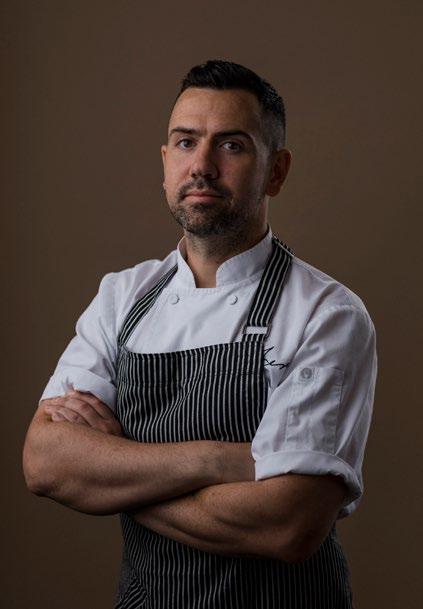
Robbins also designed AnnaLena to be a reflection of his life. “The restaurant defines the culture I grew up in. The bare bricks, the Jordans’ sneaker collection and Gameboys are all things I love, but with today’s edge put on them,” he shares. Since opening the restaurant, Robbins, with the help of his family of carpenters and interior decorators, has re-designed it eight times to keep it fresh and creative.
Having spent his career in the culinary profession, training and learning from living and working in restaurants around the world, Robbins says he didn’t have any one mentor. “Instead, it was a million little things and many chefs and teams.”
His advice to aspiring chefs is to assume that achieving success in any career is going
to be the hardest thing they will ever do. He adds, “It will be hard for reasons you did not expect, but when you look back you will realize you learned from each so just keeping working at it and you will get there.”
The decision to shift AnnaLena to a tasting-menu restaurant in 2020 was partially a response to COVID restrictions and partially a desire to create a very specific curated experience for guests. “With limited seats, [how many?] we realized we could do so much more with each plate. Our tasting menu lets our guests trust our chefs as we have created a very unique and perfectly flavoured meal experience,” explains Robbins.
AnnaLena identifies each unique six-week tasting menu by Chapter. Turnip and radish crudité with burrata, black garlic Caesar, charcoal croutons and lamb saddles with fried lamb belly, asparagus and romesco jus are just two courses offered on Chapter 63. Each Chapter includes Robbins’ original menu plus his hand-written notes listing cooking
JULY/AUGUST 2023 FOODSERVICE AND HOSPITALITY 39 FOODSERVICEANDHOSPITALITY.COM
ALLISON KUHL
techniques, local farms, producers and suppliers plus any revisions. Hannah Brook, North Arm and Hazelmere Farms, are just a few of the restaurant’s many local partners. “Because the weather et cetera impacts what our farmers can grow, I need to revise menus. Last week fresh peas were not available, so I substituted asparagus. Then when peas came in, I switched to peas,” explains Robbins.
Priced at $98, each five-course menu includes three to four additional small surprise snacks, including palette cleansers and petite fours which change with each season and Chapter. “The only menu item we consistently feature is our proprietary torn bread, that our customers absolutely love. We make three-kilogram loaves, which is then hand torn, soaked in oil and charred on very high heat.”
Wine pairings are also available for $72 and are thoughtfully curated by AnnaLena’s Platinum award-winning Wine director Reverie Beall and built around small, independent and organic producers from B.C. and around the world.

Achieving a Michelin Star was never


something Robbins actively pursued. However, achieving the star has been a proud achievement for the entire AnnaLena team.
“For our entire team, which has been together for eight years, achieving this Michelin Star together has brought us a great deal of attention, which we appreciate. We will try to continue to create a special place for our guests to enjoy and strive to improve and evolve,” concludes Robbins. FH

Covering everything from chef and restaurant profiles to culinary and equipment trends in Canada’s foodservice-and-hospitality industry. @FOODSERVICEMAG ALLISON KUHL
FOLLOW US ON INSTAGRAM
BE TRUE TO THE FOOD®










TRUE INGREDIENTS. TRUE INNOVATION. TRUE PASSION FOR YOUR SUCCESS.








THAI CHICKEN GAI YANG FEATURING CUSTOM





CHEF’S OWN™ SRIRACHA


LIME





At Custom Culinary® we’re dedicated to providing exceptional products to enhance any menu and every daypart. Our avour-forward solutions are rooted in culinary expertise and a thoughtful, innovative approach to product development, centred on clean, simple and wholesome ingredients. We bring pro table trends to life with items that meet your needs, delight your customers and exceed your expectations. Learn how we can help you Be True To The Food® by visiting CUSTOMCULINARY.CA.

SOLUTIONS
FLAVOUR GLAZES I GRAVIES I SEASONINGS
Culinary, Inc. All rights
COATING
I
© 2023 Custom
reserved.
CULINARY®
SEASONING AND SWEET & SMOKY BBQ FLAVOUR GLAZE
Pluck Tea Toronto
Pluck Tea blends, packs and delivers sustainable and ethically sourced teas
 BY NICOLE DI TOMASSO
BY NICOLE DI TOMASSO
final impression before you pay a bill, decide on a tip and make plans to return, so I think it’s an important point of service.”
Today, Pluck Tea’s team of nine is committed to making a positive impact using sustainable and ethical production methods for 12 tea types, including caffeinefree, wellness, black, green, herbal, rooibos, organic, upcycled, matcha, chai, superfine latte blends and iced-tea sachets.

Alack of good quality tea at restaurants motivated certified tea sommelier and entrepreneur Jennifer Commins to help foodservice operators create a better tea experience for its customers with the launch of Toronto-based Pluck Tea in 2012.
“Ten years ago, I noticed a big disconnect between the quality of food and the quality of tea on many top restaurant menus in Toronto, as well as service standards,” says Commins. “Several of my coffee-drinking friends would get beautifully layered espresso-based beverages with their desserts and I would get a scratched metal teapot with a tea bag still in its pouch and a dry lemon on the side. In many cases, tea is the
Some ingredients, such as lavender and ginseng, are grown and dried in Ontario. The company also sources ingredients from farms in B.C., Nova Scotia and Newfoundland. Additionally, many ingredients are upcycled to reduce food waste. Citrus peels are saved and immediately dried for Pluck Tea by Chasers Fresh Juice; cacao shells are reserved and roasted by ChocoSol Traders; and grape skins are saved after pressing for juice at Southbrook Organic Vineyards in Niagaraon-the-Lake, Ont.
“We deeply investigate and consider our sourcing practices, and we are the only tea company with Upcycled certification to create new supply-chain loops with fellow food makers in our local community,” says Commins. “It’s important to look for these opportunities because there are so many products out there that can be optimized for premium food.”
Commins continues, “It takes a lot of effort, creativity and patience. You need to be nice to people because you’re asking another company to change their business practice to potentially make their lives more complicated. For instance, Chasers Juice installed a small drying facility to help facilitate this partnership. That’s an investment on all sides, so everyone needs to be invested in these solutions.”
While the tea plant itself (camellia sinensis) doesn’t grow in Canada, Pluck Tea works directly with a growing network of
42 FOODSERVICE AND HOSPITALITY JULY/AUGUST 2023 FOODSERVICEANDHOSPITALITY.COM
ARASH MOALLEMI
Rainforest Alliance, Fair Trade and Organiccertified tea farmers to source its teas. The company partners with Rwanda Mountain Tea for its Pluck Pekoe and sources its Premium Organic Matcha directly from Kagoshima, Japan. In fact, Commins says the company’s sales have increased by 25 per cent on matcha year-over-year.
In addition to its ethical sourcing practices, Pluck Tea packages its teas, either loose or bagged, in zero-waste glass jars. Craft paper re-sealable pouches are also available. Furthermore, the company

partners with Drop Distribution, a weekly emissions-free delivery service that brings orders to customers in Toronto via bicycle or electric car.
And, during the pandemic, Commins says, “government programs allowed us to launch our online store, which has become very active for us and now a major channel of business growth [across Canada].”
Overall, Pluck Tea’s Organic Pekoe has fuelled great interest from customers. “Pekoe is the most popular tea category in Canada and accounts for roughly 60 per cent of total tea sales,” says Commins. “I decided it would be fun to think about tea and coffee together and create three different blends – light, medium and bold – to follow the logic of roasting levels in the coffee world. These teas are capturing a lot of interest in foodservice.”
Pluck Tea’s signature blends comprise the largest share of foodservice sales, but the company also facilitates a white-label business. Customers include Oliver & Bonacini Hospitality, the Drake Hotel, the Royal Hotel, 360 Restaurant, Café Belong, Pilot Coffee Roasters, Propeller and Recipe Unlimited (multiple brands). Pre-pandemic, Commins says 85 per cent of Pluck Tea’s sales were from foodservice, education or office. Today, 50 per cent is retail and direct to consumer.
“Recipe Unlimited is one of our big clients and its franchisees are loving our teas,” says Commins. “We’re working with them on many customized drink concepts and tea programs for adult menus, as well as kids’ menus. Luring kids away from sugary sodas and toward craft herbal caffeine-free iced teas has been fun, as many of our teas come in vibrant and unexpected colours. We’re also seeing a boom in no/low-alcohol cocktail menus, so we’re working with bartenders and mixologists to create innovative blends that are sophisticated and pair well with food.”
As for the future, Commins is looking to partner with larger organizations to accelerate growth. But for now, Commins says the company is happy to keep doing what they’re doing to grow organically, order by order. FH

JULY/AUGUST 2023 FOODSERVICEANDHOSPITALITY.COM
WE DEEPLY INVESTIGATE AND CONSIDER OUR SOURCING PRACTICES, AND WE ARE THE ONLY TEA COMPANY WITH UPCYCLED CERTIFICATION TO CREATE NEW SUPPLY-CHAIN LOOPS WITH FELLOW FOOD MAKERS IN OUR LOCAL COMMUNITY
Montreal-based Northfork Bison Distributions Inc., founded by Rocco Verelli in 1997, operates one of Canada’s largest bison meat processing plants. In addition to its flagship bison meat, Northfork Bison also sells game meat products, including elk, venison, ostrich and wild boar.

In the beginning, Verelli saw huge potential in alternative meat sources. After gaining several years of experience in the restaurant and food business, he decided to pursue his passion for farming and began raising a couple of head of bison in Montreal. His first customers include Dutchess Diner and Alexis Diner in New York.
Today, Northfork Bison serves the entire North-American market. Its processing plant spans more than 10,000 sq. ft. and employs more than 40 people. Most recently, the company entered an agreement to supply its bison burgers to Energy Fuel, a restaurant chain located in the New York City area.
“There has been steady growth over the years in the demand for bison, wild boar, elk and ostrich,” says Verelli. “In the last year or so, there has been a significant jump in sales for these products across Canada. [Although] the plant-based market has grown over the years, it doesn’t seem to have impacted the demand for wild game meats. What this tells us is that the consumer is more proactive than ever in searching out healthier eating alternatives.”
Northfork Bison
MONTREAL
The trend towards less traditional meat choices is fuelling business
BY NICOLE DI TOMASSO
Additionally, the company’s bison are now raised throughout Alberta, Saskatchewan and Manitoba. “Unlike most other traditional meats, there are no growth hormones or antibiotics used in the raising of bison, which is a very good thing for the consumer,” says Verelli. “In addition, bison is a leaner protein than beef, which is great if [a customer] is trying to maximize nutritional benefit while reducing calorie or fat intake.”
Over the course of the pandemic, Northfork Bison’s e-commerce sales, which offers more than 40 products, surged. And, while foodservice sales took a hit, retail sales were up and provided a financial cushion.
“The pandemic led to the temporary, and sometimes permanent, shutdown of many restaurants throughout North America,” says Verelli. “As a result, the foodservice side of our business shrank significantly. Thankfully, we already had a presence on the retail side, allowing us to shift our focus
there while waiting for the foodservice side to come back. In so far as the supply chain, we have managed to hold our own. We attribute this to the strong relationships we have established with our network of bison ranchers throughout Canada. The other big advantage that we have is our well-developed distribution network. We have our own fleet of refrigerated trucks along with strategicallylocated storage warehouses.”
Northfork Bison is now prioritizing its restaurant partners, working diligently to help them recover from the devastating impacts of the pandemic.
“We are working with [our restaurant partners] on menus, special promotions [and more] to help them get back on their feet,” says Verelli. “In addition, to help soften the blow from inflation, we are doing everything within our power to try and control our costs by optimizing our procurement, processing and distribution procedures.” FH
44 FOODSERVICE AND HOSPITALITY JULY/AUGUST 2023 FOODSERVICEANDHOSPITALITY.COM
NotCo
San Francisco, Calif.
Leading food tech, NotCo, continues expansion
BY MORAG MCKENZIE
Karim Pichara, co-founder and CTO of NotCo, loves to share the fact that pineapple has the same molecular equivalent as dairy milk.
NotCo, a food tech company creating plant-based foods, uses a proprietary artificial-intelligence (AI) technology named Giuseppe, to allow its team of chefs and food scientists to match animal proteins to their ideal replacements among thousands of plant-based ingredients. Founded in 2015 in Chile by three technologists, Pichara, Matias Muchnick (CEO and Pablo Zamora, NotCo first expanded to Brazil and then the rest of Latin America. In 2021, the company expanded to North America, and is now partially owned by a consortium of private investors.
Giuseppe uses a proprietary algorithm that learns and studies infinite combinations of foods at the molecular, physical and chemical level. The technology works on the formulation of recipes, runs sensory studies and, with the support of NotCo chefs, learns from the internal feedback analyses so its products are continually improving in taste and texture. As a result, NotCo’s products offer the delicious tastes and unique textures customers demand, but are made entirely from plants. The company’s current product line includes NotMayo, NotMilk (1 per cent, 2 per cent and whole), NotMilk Chocolate, NotIceCream, NotBurger and NotChickenNuggets. The products are available at major retailers and limited foodservice operations across Canada.
“NotCo was born because we love food and we don’t want to change what we like so much about it. But today, what we love to
eat is hurting us and the environment,” says Muchnick. “We believe that replicating the animal products we all love to eat, but using plants, gives us all an opportunity to reduce our environmental impact without even realizing it. We are here to create a different food system — re-invent it, actually — without animals for everyone, everywhere.”
Pichara plays a critical role in NotCo’s growth and product development. “I’m responsible for delivering the AI technology that NotCo needs to accomplish its mission,” he says. “I have to make sure that at the AI team, we are creative, collaborative and focus on achieving results.”
Creating a more sustainable food system is at the heart of NotCo’s mission and vision. Global food production, which is based on animal farming, uses up one-third of the earth’s surface and emits more CO2 than the world’s transportation emissions combined. NotMilk milk uses 84-per-cent less water and generates 79-per-cent less CO2 than the production of dairy milk, while NotBurger uses 93-per-cent less water and generates 95-per-cent less CO2 than animal-based burgers. NotCo’s commitment to reducing their environmental impact extends to their straw-less packaging and commitment to offsetting their carbon footprint.

In February 2022, NotCo joined forces with Kraft Heinz in a historic, first-of-itskind partnership to “democratize” access to plant-based foods. By combining Kraft Heinz’s iconic brands and powerful scaling with NotCo’s AI-driven food tech, Kraft Heinz
stated the partnership would develop new products with an “unprecedented focus” on speed, quality and scale. Just eight months later, the KraftHeinz Not Company unveiled its first offering: NotMayo and NotCheese Slices. The Kraft-Heinz Not Company partnership has plans to expand to seven categories and embark on international expansion in 2024.
“When we started NotCo, it was our goal to make our technology a catalyst for a more sustainable food system, not only for us, but for other brands and manufacturers who share the same ambition,” says Muchnick. “This is an exciting milestone for the plant-based industry and shows the power of technology’s role in driving mainstream adoption.”

Besides the development of new products, the joint venture partnership will provide commercial support to the NotCo brand, allowing NotCo to accelerate availability and scale of its products.
In April 2023, NotCo partnered with Hero Certified Burgers, a long-standing leader in the fast-casual dining sector in Canada. NotCo plant-based products are now available at their restaurants, giving customers a more sustainable, delicious plant-based menu option.
“Canadians are looking for food alternatives and we are thrilled to be able to serve elevated plant-based food items to our customers alongside an innovative company like NotCo, which uses advanced technology to re-create impressive plant-based and nonGMO options,” says John F. Lettieri, founder, president and CEO of Hero Certified Burgers.
Named to Fast Company’s annual list of the World’s Most Innovative Companies, NotCo has plans to continue to expand their product offerings and locations in both the retail and foodservice sectors across Canada and internationally. FH
JULY/AUGUST 2023 FOODSERVICE AND HOSPITALITY 45 FOODSERVICEANDHOSPITALITY.COM
Organic Ocean
RICHMOND, B.C.
The company’s mission is to responsibly harvest seafood that benefits both the environment and society

 BY SUZANNE CHIN-LOY
BY SUZANNE CHIN-LOY
46 FOODSERVICE AND HOSPITALITY JULY/AUGUST 2023 FOODSERVICEANDHOSPITALITY.COM
Organic Ocean does more than just sell fish. The Richmond, B.C.-based company, founded by fishermen Dane Chauvel and Steve Johansen in 2008, has built a reputation for going above and beyond in terms of quality and eco-conscious practices.
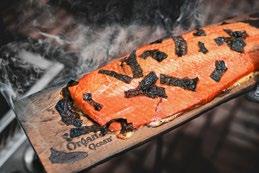
“We’ve been committed to sustainability well before sustainability became mainstream,” says Chauvel, CEO. “In fact, when we established Organic Ocean and shared our vision for sustainable harvest and production, most within our industry met us with mild amusement.”
Organic Ocean revolutionized the seafood supply chain by eliminating intermediaries, including brokers, distributors and wholesalers, spawning the creation of a unique platform for seafood producers.
“[We wanted] to deliver a high-quality product and optimize the value of the resource,” says Chauvel. “We were dealing with a commoditybased industry where all the fish, regardless of how they were harvested and handled, were dumped into the same bin. So, rather than dealing with the [traditional] supply chain, we created our own.”
By using this approach, Organic Ocean has found a direct link between producers and endusers. The company has also partnered with Indigenous fisheries and other like-minded harvesters. These collaborations established a more efficient and effective supply chain, focusing on selling sustainable, high-quality products directly to consumers.

Organic Ocean is committed to promoting sustainability in a world where overfishing and environmental harm are prevalent. It prioritizes transparency by providing traceable and verifiable products, including salmon from the North Pacific and West Coast of Canada, scallops from Japan, fair-trade blue shrimp from Mexico, and Humboldt Squid harvested in Peru.
“All our products are required to be sustainably harvested and produced,” states Chauvel. “Wherever possible, our products must comply with an independent, thirdparty standard like OceanWise, Seafood Watch, or Marine Stewardship.”
“In terms of traceability, it’s challenging following seafood through the supply chain when you consider how it is being transformed by processing. And when it loses the morphological characteristics (skin, head, tail, fins), it becomes very difficult to distinguish species,” he adds.
The company uses DNA authentication as a reliable way to verify the species and
tackle the widespread issue of mislabelling, which is a matter of concern from both consumer and environmental viewpoints.
“When seafood is mislabelled, this almost always involves misrepresenting a lower-value product as a higher-value product. It’s also important to know that the species has been harvested from abundant stocks, which is impossible if it’s not honestly labelled.”
Organic Ocean has entered a partnership with the Hanner Lab in the College of Biological Sciences at the University of Guelph, which has pioneered the use of DNA barcoding technology in which a short, specific section of a particular gene from a sample is sequenced and compared with a library of barcodes from known species.” It also uses viable packaging materials whenever possible, such as biodegradable, compostable, or recyclable products.
“Through [our partnership] with a start-up from the University of British Columbia, we are developing and evaluating a 100-per-cent bio-based plastic-film replacement using water, seaweed, and wood pulp fibre that is as effective and affordable as traditional plastics but with the added benefit of being completely compostable in soil,” says Chauvel.
Although Chauvel takes great pride in the wide variety of his seafood products, he believes that seaweed, kelp, and cultured shellfish are the products of the future due to their cost-effective production and positive environmental impact.
“[Besides being] very nutritious, shellfish filter the water, and seaweed and kelp help us to sequester carbon dioxide,” he says. “I love creating a range of seaweed and kelp products. We believe that it’s strategically important from an environmental perspective. In addition to all the other things we do, innovating gives us a competitive edge and better serves the market’s needs.”
Organic Ocean has expanded its seafood supply to the home consumer, along with preparation tips shared by the chefs they supply, which aim to create a five-star dining experience at home.

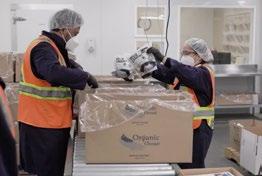
“[The home cook] loved the notion of sourcing the same high-quality seafood that had become the preferred choice of the top chefs, but many were unfamiliar with what to do with it once they got it,” says Chauvel. Working with some of the very best seafood chefs (under the direction of our Chief Culinary Officer Robert Clark), we began creating a line of chef-crafted seafood that would be super easy for any home cook to prepare.”
Chauvel says Organic Ocean’s seafood products have also caught the attention of universities and businesses. “We are growing rapidly, domestically, and globally, and this is enabling us to increase our positive environmental and social impact – that is key to our overall mission.” FH
JULY/AUGUST 2023 FOODSERVICE AND HOSPITALITY 47 FOODSERVICEANDHOSPITALITY.COM
West Avenue Cider House
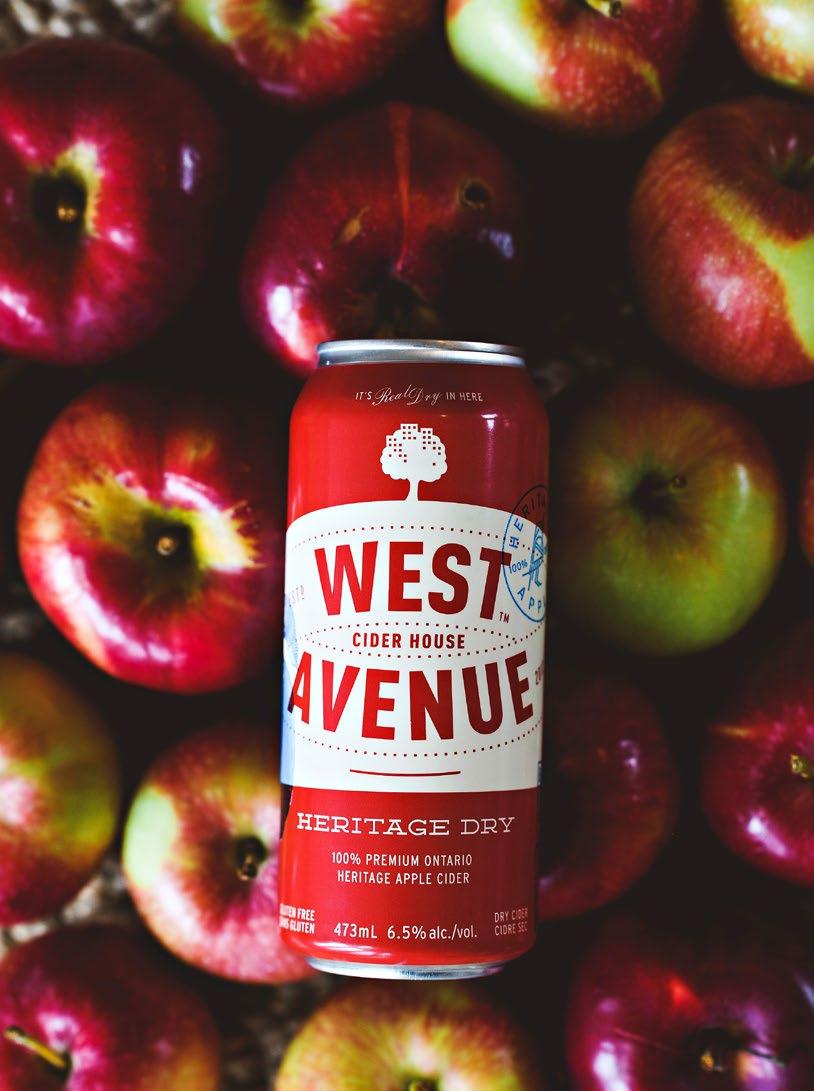
Carlisle, Ont.
BY DENISE DEVEAU
Good taste makes for good business for Ontario cider producer
n 2012, Chris Haworth and his wife Amy Robson were at a crossroad in their respective careers.
Given Haworth was an executive chef, the obvious choice was opening a restaurant. “But we wanted to spin it around and do something where we didn’t have to work until midnight or on holidays,” says Robson.
So, instead, they took the road less travelled to start their own venture: West Avenue Cider House.
From humble beginnings in a leased warehouse and supplying a handful of foodservice customers, their allnatural quality and award-winning hard ciders are now distributed to more than 300 independent restaurants and bars in Ontario. The company home is now a 75-acre property in Carlisle called Sommerset Orchards, where they grow more than 100 varieties of heritage apples and 10 varieties of pears.
The interest in cider came naturally for the British-born Haworth. “There is so much amazing cider there,” says Robson. “When we came to Canada, no one was doing that except for some sweet ciders coming out of B.C.”
Haworth, who always had an interest in brewing and winemaking, went to work developing cider recipes. At first, they ran a remote model, living in Toronto, sourcing apples, and renting space in another cidery for production. Their first product, Heritage Dry, sold out in the first year and remains their biggest seller to this day. Other bestsellers include Cherriosity and one of their
latest creations, Little Mac.
With a successful launch, and demand exceeding supply, they decided to purchase the farm in 2015. They planted 6,000 apple trees, renovated the property, and set up a tasting room.

“The dream was always to have a place to call our own, to plant apples, and welcome people to try our products,” says Robson. They have since added a rental cottage, farm bakery and store.
All the apples grown on the property are heritage, she explains. “We grow true cider fruit – not the more familiar apples for eating like Golden Delicious or Honeycrisp. We’re after apples that are bitter and tannic.”
She estimates the company averages 25 different releases a year. “Our offerings are constantly evolving. We always have six draft lines and six different bottles to try here at any given time.”
Since they started operations, the competitive market for cider has exploded, says Robson. “When we started, there were 15 cideries in Ontario. Now there are 150. It’s much more competitive, but the quality of our cider is really high because we grow a lot of our own fruit and the flavour really stands out. While a lot of those competitors are virtual like we were when we started, we can do it all, from orchard to glass.”
The biggest competition these days is the RTD (ready-to-drink) category, she notes. “For four years RTDs have been taking the bite out of beer and cider. Beer has taken a bigger hit, while cider seems to have plateaued.”
West Avenue Cider’s continued strength in the market lies in the quality of the fruit and a slow, natural six-month fermentation process. “Anything less than that would not be fermented naturally,” she says.
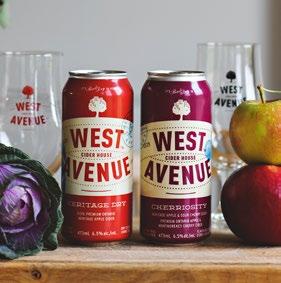
Winning numerous awards over the years has helped them keep pace with the growing field of competitors. Accolades include multiple wins in the Great Lakes and International Cider and Perry Competition (GLINTCAP), and the Canadian Cider Awards. Its Northern Lights ice cider also won a double gold at the All-Canadian Wine Championships, an award that Robson says, “brings you to different level”.
Another milestone of note was getting their products into the LCBO in 2020.
Robson is especially proud of the fact they have received a 2023 Regional Tourism Hamilton-Halton-Brand Responsible Tourism Award, a nod to their long-standing commitment to sustainable practices.
“Our orchard is organic. We have 500,000 honeybees that come and pollinate everything on the farm, and the sheep can go and fertilize the orchard. That’s the type of sustainable type of agriculture we practice. Everything we touch, from the meat and cheeses to the eggs and maple syrups we sell on the property, is from Ontario.”
The focus this year and next is to expand the offerings on the property. “We’re trying make the farm a destination place for Ontario,” says Robson. “We’ve added a permanent campfire and are in the process of installing an outdoor wood oven for outdoor cooking so guests can come and make a day of it.”
While they hope to expand in Canada, they are taking their time working out the logistics. “Distribution to Canada and beyond is not easy,” says Robson. “We have to think about what’s involved before we expand further.”
As a small supplier, it doesn’t compete with the big brands that you find in chains, she adds. “We’re much more aligned with smaller partners that really focus on the quality of their products – just like us.” FH
JULY/AUGUST 2023 FOODSERVICE AND HOSPITALITY 49 FOODSERVICEANDHOSPITALITY.COM
CHRISTINE KUFSKE
Chris Haworth and Amy Robson
SUSTAINABLE ACTION

GUSTO 54 RESTAURANT GROUP HOLDS ITSELF ACCOUNTABLE FOR ITS SUSTAINABILITY EFFORTS
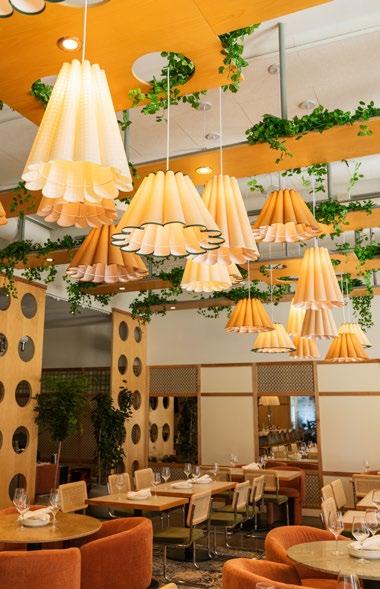 BY NICOLE DI TOMASSO
BY NICOLE DI TOMASSO
Gusto 54 Restaurant Group approaches community, sustainability and environmental stewardship with the same vim and vigor that its namesake implies. Across its collection of restaurants and culinary experiences in Toronto and Los Angeles, the company — the winner of KML’s 2023 Green Leadership Award in the restaurant category — is committed to reducing its environmental impact by minimizing waste, conserving resources and creating a more responsible business model that aligns with its core values and resonates with guests.
50 FOODSERVICE AND HOSPITALITY JULY/AUGUST 2023 FOODSERVICEANDHOSPITALITY.COM GREEN LEADERSHIP
GABBY FRANK
SUSTAINABLE ACTION

Among its restaurant sustainability practices, Gusto 54 uses energyefficient light bulbs at all locations to reduce energy usage and save costs. To further reduce energy consumption, sensor lighting is used in bathrooms and natural light is taken advantage of where possible to brighten up spaces. Also, team members are encouraged to turn off lights and equipment when they aren’t in use.
To reduce carbon emissions and air pollution, the company has only one delivery van for all seven restaurants in the Greater Toronto Area (GTA). Additionally, Gusto 54 works closely with local food purveyors, such as Bondi Produce, to minimize transportation distances.
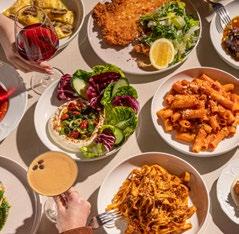

With regard to water conservation, Gusto 54 uses Tabl’eau Filtered Water at its newest restaurant, Café ZUZU. By installing an ecoforward system of filtered water on site, the company has eliminated the added transport, storage and recycling of traditional bottled, packaged and delivered water, resulting in significant cost savings for the business.
In the area of waste management, Gusto 54 uses compostable packaging for its restaurant takeout containers. Recently, the company partnered with Rethink Resources, Canada’s most comprehensive and environmentally friendly waste-management system, to ensure its waste is diverted from landfills and contributes to a circular economy. In the last calendar year alone, the company has diverted more than 200,000 lbs of waste from landfills.
Through its partnership Rethink Resources, Gusto 54 can also regularly monitor and report on its sustainability initiatives to measure progress and identify areas of improvement. Additionally, the company, in collaboration with Rethink Resources, creates extensive training videos featuring its restaurant chefs who educate employees on its sustainability standards and encourage them to incorporate the best practices into their daily work routines.
In addition to the company’s internal efforts, Gusto 54 is committed to sharing its practices with the public and external markets through social media and other digital channels to encourage the adoption of similar practices in their own lives. In fact, the company plans to launch a sustainability club to engage with its community by providing a forum for discussion and collaboration. On an annual basis, the company also participates in garbage pickups, clothing exchange and training sessions on how to eat and cook more sustainably. On the company’s catering side, Gusto 54 is LEAF certified, which reflects its commitment to providing sustainable dining experiences. One of its current efforts is researching the carbon footprint of its meals, including beef, chicken and vegetarian options. The research compares the carbon emissions associated with each meal and considers the source and transportation methods of ingredients.
Gusto 54 continuously explores and implements new ways to reduce its environmental impact as it works towards a more sustainable future for the business. “We need to be kind to our planet and [Gusto 54 has always been] committed to being part of the solution, but we can’t do it alone,” says Juanita Dickson, president of Gusto 54 Restaurant Group. “I encourage all restaurants and hotels to look toward sustainability to support our future.” FH
JULY/AUGUST 2023 FOODSERVICE AND HOSPITALITY 51 FOODSERVICEANDHOSPITALITY.COM





52 FOODSERVICE AND HOSPITALITY JULY/AUGUST 2023 FOODSERVICEANDHOSPITALITY.COM EQUIPMENT
INDOOR AIR QUALITY REMAINS A CONCERN

 BY NICOLE DI TOMASSO
BY NICOLE DI TOMASSO
Until the COVID-19 pandemic, foodservice operators rarely thought about indoor air quality as a serious health concern. To improve air quality in restaurants, the standard guidelines for hygiene and sanitation are no longer sufficient to ensure the health and safety of staff and customers. In addition to those response measures, commercial air purifiers have become must-have pieces of equipment.

While minimizing the risk of COVID-19 transmission was top of mind for operators during the peak of the pandemic, a better understanding of air quality and where supplementary issues are most likely to occur has been brought to the forefront.
CAUSE & EFFECT
Not surprisingly, a restaurant’s kitchen is the primary source of poor air quality as grills, ovens and stoves produce large amounts of smoke and grease and create harmful emissions. If the HVAC system is in bad condition, the restaurant won’t be able to effectively filter and improve the air quality. Additionally, poor air quality can lead to the growth of mold and mildew, causing food to become contaminated and spoil.
“In a professional kitchen, there are a lot of grease-laden vapours generated by the cooking equipment that become airborne,” says Steeve Meehan, director of National Accounts and corporate chef, Food Service Solutions in Mississauga, Ont. “Commercial-grade air purifiers can help neutralize odours and kill bacteria. Prior to the pandemic, air quality wasn’t a mainstream focus but many people now have a new appreciation for clean air.”
To put it simply, there are two types of harmful things in the air. “It’s either pathogens, which can be bacterial, viral or fungal, or pollutants such as gases and particulate matter, which can be broken down further into different components,” says Dr. Lukasz Porosa, chief chemist, inventor

FOODSERVICEANDHOSPITALITY.COM
JULY/AUGUST 2023 FOODSERVICE AND HOSPITALITY 53
Bluezone Ready-To-Go-Tower Black
Jaspr Pro
of pathogen protection technologies and consultant." He also teaches a seminar entitled Indoor Air Quality: A Breath of Fresh Air for industry professionals through the Resilient World Institute.
For customers, the smell, heat and humidity can significantly impact their overall dining experience. For staff who spend many hours a day in the space, poor air quality can impact productivity, activate allergies and trigger headaches, dizziness, nausea and more. And, at a time when the industry is experiencing record-high job vacancies, maintaining a clean work environment can help attract top talent.
“COVID has brought an awareness of the environment that we experience when we go to restaurants, urging a call to action for the need to address, monitor, understand and remediate the air quality in restaurants and by extension to all environments that we work and play in,” says Leon Wasser, director, School of Energy, Resilient World Institute, and vice-chair, Ontario Sustainable Energy Association.
WHAT’S AVAILABLE?
The majority of air purifiers work the same way, according to Dr. Porosa. They consist of a filter, or multiple filters, and a fan that sucks in and circulates air. “It really comes down to how fast the fan draws air into the filter and the efficiency of the filter itself. Most air purifiers use a HEPA filter, which can remove a minimum of 99.97 per cent of airborne particles that are 0.3 microns in diameter,” he says.
Launched in 2020, the Jaspr Pro air purifier offers a Clean Air Delivery Rate (CADR) of over 600 and removes more than 99 per cent of airborne pollutants. The filter should be replaced every six months and its effectiveness stands at a 430 CFM airflow rate for maximum output. It operates quietly at only 30 decibels and covers up to 1,600 sq. ft. with eight-foot ceilings. Weighing only 25 lbs, its steel body construction is recyclable, nonpollutant and durable. Additionally, the Jaspr Pro features three modes: smart mode, dark mode and deep-clean mode. According to its website, the Jaspr Pro costs CAD$1,399.
With dozens of foodservice customers in Canada, including Garlics of London in London, Ont., as well as food manufacturers and commercial kitchens/ghost kitchens, the Jaspr Pro has also grown to become a trusted choice in home and healthcare settings.
“We want to eat food, we don’t necessarily want to inhale all of the particulate,” says Mike Feldstein, founder and CEO of Jaspr.
MEASURING WHAT MATTERS
Measuring carbon dioxide from indoors against outdoor air acts as a standard indicator for the effectiveness of a restaurant’s ventilation. Depending on size and model, CO2 monitors are relatively inexpensive to buy.
“If there are too many people in a restaurant and the air is not being vented properly outside, there’s going to be a buildup of CO2 and consumers will be breathing each other’s air,”
“COVID made air purifiers go from a want to a need, from a vitamin to a pain killer.” To keep up with the demand at the onset of the pandemic, Feldstein says the company opted for air freight instead of sea freight as a faster, safer and more reliable option.
Furthermore, Oregon-based EVO America offers air purification solutions for restaurants using UV technologies. The Bluezone by Middleby 450 Viral Kill units are ideal for indoor dining and FDA certified. The units use a combination of self-contained UV light and room-temperature oxidization to destroy viruses and volatile organic compounds, destroying up to 99.9995 per cent of airborne infectious aerosols. Weighing only 25 lbs, the 450 Viral Kill unit treats up to 9,000 cubic feet and bulb life lasts up to 8,800 hours or one year of continuous operation.
The Bluezone by Middleby 2400 model, on the other hand, is a UV food preservation system that’s designed to eliminate contaminants such as ethylene, mold, bacteria and odors in walk-in coolers. Treating up to 15,000 cubic feet, these units can be ceiling mount or shelf mount, increasing the shelf life of food from five days up to 25 days, ultimately reducing waste and saving money. Each Bluezone unit costs CAD$5,823 and CAD$5,695 respectively, according to Canadian distributor iFoodEquipment.ca.
“A lot of operators prefer to put the Viral Kill unit in a ready-to-go tower that makes them look more attractive in [a restaurant space], but still allows the contaminated air to get in and get out,” says Scott Heim, president, Ventless Solutions, The Middleby Corporation.
says Dr. Lukasz Porosa,
chemist,
inventor
chief
of pathogen
protection technologies and consultant.“Humans are the source of viruses and bacteria, so if someone is infected then large particles can remain in the air for several minutes and small particles can remain in the air for hours or even days. When operators heat and cool their restaurants, those particles will be freefloating and moving around.”
“At Room 623, we consistently make sure our audiences are aware of our commitment to their safety and that has been reinforced by the presence of the Bluezone unit,” says Marcus Goldhaber, creative director at Room 623 in Harlem, New York. “With the help of Dennis Francis, Scott Heim and the team at Evo America, we’ve been able to not only re-open our doors but also provide consistent comfort to our guests who are continually grateful for this effort towards creating a safe place to gather.”
In Canada, additional distributors include Mississauga, Ont.-based Nella Group Inc., Toronto-based Russell Hendrix, and Brampton, Ont.-based JFS Restaurant Equipment, among others.
While portable solutions are effective for most restaurants, Dr. Porosa adds restaurants that can run up to hundreds of thousands of dollars might consider HVAC upgrades, which are more expensive and time consuming.
“It’s called Heat Recovery Ventilation (HRV) which is a system that uses the heat in stale exhaust air to pre-heat incoming fresh air, or Energy Recovery Ventilation (ERV), which transfers both heat and moisture,” he says.
Dr. Porosa continues, “The challenge with indoor air is it’s something we can’t see, so we tend to forget about it. We expect clean drinking water, but we don’t really expect clean air. It’s more complicated because every establishment has different ventilation systems and upgrading them can be expensive, but we spend most of our time indoors, so it’s important for operators and consumers to be aware of all their options.” FH
54 FOODSERVICE AND HOSPITALITY JULY/AUGUST 2023 FOODSERVICEANDHOSPITALITY.COM
BOTTOMS UP!
The 2023 BAR Report shows a new generation of customers is turning beverage-alcohol trends upside-down
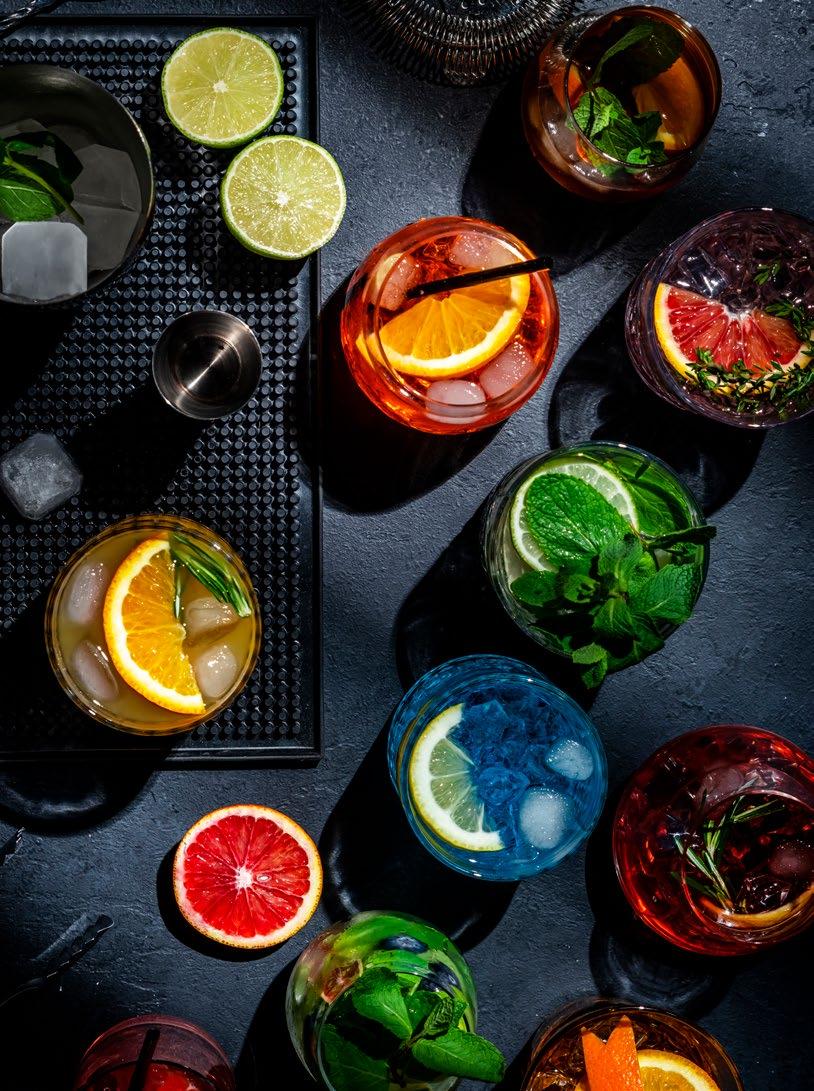 BY SARAH B. HOOD
BY SARAH B. HOOD
JULY/AUGUST 2023 FOODSERVICE AND HOSPITALITY 55 FOODSERVICEANDHOSPITALITY.COM POURING FOR PROFITS
ISTOCKPHOTO.COM/5PH
“It’s a brand-new world; everything that we thought we knew, we didn’t know,” says CJ Hélie, president of Beer Canada. “Very few of those trends are anywhere to be seen, and there are new factors at play.”
“There’s a lot of pent-up demand, but also the pressures of inflation,” says Asad Amin, head of Syndicated Solutions for Canada at marketresearch firm Ipsos. Normally, 20 cents of every dining dollar go towards alcohol, he notes, but during COVID closures, that ratio “took a massive dip because foodservice was gone,” and alcohol spending is still comparatively low.
“We’re seeing big shifts,” Amin says. “Wine and beer both have taken a hit. All other types, from cider to coolers, have been growing. Historically, the older cohorts are the ones that skew towards alcohol consumption; younger cohorts have a high repertoire of beverages.”


On the heels of tougher drinkingand-driving laws that dampened alcohol sales in many provinces, along with minimum-wage increases that put pressure on payrolls, COVID hastened the introduction of a range of new measures with the potential to help or hinder various sectors the foodservice industry. Permitting takeout and delivery of alcohol with meals helped many outlets survive COVID lockdowns,
but has presumably habituated many consumers to staying in rather than dining out.
Beer Canada has tracked more than 20 municipalities across Canada that now allow alcohol consumption in certain outdoor areas: typically parks. Meanwhile, convenience-store chain 7-11 now serves alcohol in some outlets with foodservice seating, and some regions that did not previously permit alcohol sales in corner stores are re-examining the issue.

While supply outlets are expanding, demand is actually dwindling, Hélie says. “Per-capita consumption is on the decline; drinking and driving, binge drinking numbers are down. Lighter alcohol has accelerated; in the last twoand-a-half years, it’s been 20 per cent to 25 per cent growth.”

56 FOODSERVICE AND HOSPITALITY JULY/AUGUST 2023 FOODSERVICEANDHOSPITALITY.COM
Picture someone ordering a drink. You’ve probably imagined something alcoholic served in a glass at a restaurant or bar. But for the new generation of consumers that has entered the scene since COVID began to recede in the rear-view mirror, none of these is a given, and the dominant trends of the pre-pandemic years are no longer an accurate barometer of consumer desires. Now, the beverage of choice may be non-alcoholic, it may come in a can, and it may be consumed in a park or at home on the sofa.
Seagram Island Time Botanical Lychee Spritz
The Canadian Centre on Substance Use and Addiction’s revised guidelines for safe levels of alcohol, released in January, surprised many consumers and industry stakeholders alike; they essentially urged adults to limit their alcohol consumption to two drinks per week or less. However, they are in step with a general post-COVID movement towards healthier lifestyle choices, and the trend cannot be ignored. For instance, in May, the Spring/Summer 2023 LG Trends Report from LG Electronics Canada showed a 220-per-cent rise in global searches on Pinterest for “fancy non-alcoholic drinks.”
READY AND WAITING
Along with the surge in takeout and home-delivery meals, the Ready to Drink (RTD) category has grown enormously, and shows no signs of subsiding. At music venues, festivals, craft breweries and takeout picnics, young consumers are continuing to reach for a drink in a can. For venues, it’s a convenient alternative to glasses or bottles, and for producers, creative labelling offers a chance to stand out in a crowded market.
“When it comes to RTD products, seltzer is still king, representing the largest share
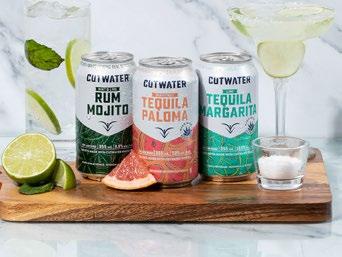
of sales. However, the growing interest in canned cocktails, hard teas and even some more traditional coolers, demonstrates that the category has much wider appeal and continues to recruit new customers,” says a spokesperson for Ontario’s Liquor Control Board (LCBO), who notes that vodka is the dominant RTD base, but also notes customers are also exploring drinks made with gin, rum, whisky and especially tequila-based RTDs.
The category has seen an enormous explosion of new lines and flavours from Canadian and international producers. In March, for example, Seagram’s added Island Time Botanical Lychee Spritz to its existing line of Island Time coolers, which already included Island Time Anytime and Island Time Coconut Lime.
April saw the Canadian introduction of premium canned cocktails from Mexico’s Tequila CAZADORES, including Paloma and Margarita cocktails. In May, San Francisco-based Cutwater canned cocktails launched in Canada under the auspices of Labatt Breweries. The top-selling U.S. craft-spirits brand offers Rum Mint Mojito (5.9 per cent ABV), Tequila Grapefruit Paloma (seven per
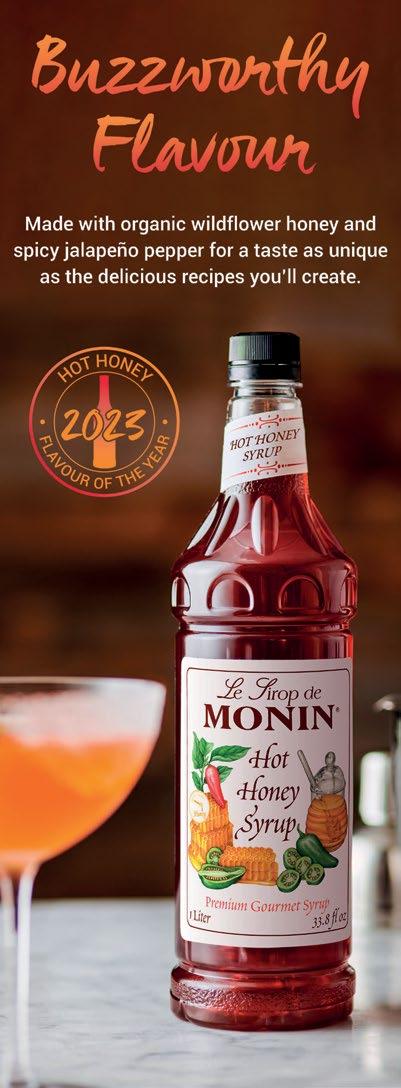
FOODSERVICEANDHOSPITALITY.COM
CNW GROUP CUTWATER CANADA
Cutwater Canned Cocktails
cent ABV) and Tequila Lime Margarita (12.5 per cent ABV).
The category is so popular, in fact, that Beerlicious, Toronto’s 25-year-old festival of beer (which runs from July 28 to 30 this year), is creating a dedicated space called “Beyond Beer” to accommodate it.
“Ready-to-Drink being a significant growth player in the category, we are carving out a piece of the site to allow for these non-beer products to be showcased,” says Beerlicious’ president Les Murray, adding that many of Ontario’s traditional craft brewers (Great Lakes, Steam Whistle, Flying Monkey, Collective Arts) are entering the RTD arena with flavoured beers and canned cocktails.
“Negronis, margaritas, Manhattans, bourbon sours: they’re all coming in that RTD format and having a lot of success,” he says. “The adage is that it’s not my dad’s beer any more. There has been a bit of a

shift in consumer choice coming in with the people who are coming of legal age. At the same time there’s that younger group of sober-curious people who are enjoying products that are made with low to no alcohol.”
IN PURSUIT OF VALUE
According to the latest figures from Statistics Canada, which cover April 2021 to March 2022, Canadians are still buying more beer than any other alcoholic beverage; it represents 34.9 per cent of total sales, with wine close behind, at 31.3 per cent, followed by spirits (25.8 per cent) and the mixed category of “ciders and coolers” (eight per cent). But beyond the question of which drink to choose, consumers are looking for inflation-beating value, which is lessening their appetite for premium products. An exception may be wine, where LCBO figures suggest that customers are buying less overall, but spending more on premium
products, with strong interest in sparkling wines, California wines and rosé and a returning enthusiasm for Ontario icewine, which saw more than 52 per cent growth over 2022.

Instead, says Asad Amin, younger consumers are looking for brands that demonstrate support for local communities, sustainability and Fair-Trade practices. “That’s what allows you to have a connection to your frequent patrons,” he says.
GLASS HALF EMPTY
Although, as Statistics Canada notes, beer remains Canada’s drink of choice, “there’s no doubt that the last three years have been incredibly challenging for the brewery sector,” says CJ Hélie of Beer Canada. In 2021, “54 per cent of brewers selling less than $5 million were not profitable, and things got worse in 2022.”
In early March, Carlsberg Canada Inc. acquired Waterloo Brewing Ltd. of Kitchener, Ont. Founded in 1984, Waterloo was Ontario’s oldest and largest Canadian-owned craft brewery; the sale is emblematic of a climate that is seeing breweries entering into new business partnerships to survive.
“In 2022, sales were still down 20 to 25 per cent, and we’re still 15 per cent below pre-pandemic numbers,” says Hélie. “The one thing that has not changed is focusing on local; 88 per cent of the beer consumed in Canada is made here, which is almost unique in the foodservice sector and certainly in the beverage-alcohol sector.”

TREND WATCH
Grant Sceney is the Creative Beverage director at Fairmont Pacific Rim in Vancouver. Among the bar spaces he
oversees is Botanist Bar, winner of Michter’s Art of Hospitality Award 2023 and number 19 on North America’s 50 Best Bars 2023 rankings.
“Batch cocktails and RTDs will continue to grow,” he predicts. “At our establishment people still try one of the cocktails, but they want less shots.”
Instead, they’ll opt for fresh creations, such as the Botanist’s Martini ($20), “served with an oyster leaf on top — it tastes exactly like an oyster. With that we do a vegan caviar, a compressed cucumber in a tight ball. It looks like a very elegant garnish,” Sceney says.
Fermentation can be the mixologist’s friend, too. “Kombucha and fermentations are going to continue to grow and be huge because obviously fermented foods are good for your stomach. We’re seeing a lot of bars playing with their own fermentations,” he says, naming Mother Cocktail Bar in Toronto and Noma in Copenhagen.
But Sceney believes that above all other strategies to survive and thrive in the beverage-alcohol arena, from canny pricing to clever marketing, the most important quality is authenticity. “If you want to stand out, be authentic to yourself.”
For instance, “if you want to take the sustainable approach, you can cut out straws, you can recycle and compost, and you can tell your suppliers not to ship in plastic any more — as long as you make it part of your company’s DNA,” he says. “But if you’re doing it for your customer’s attention and you’re not doing it for the right reasons, then customers will notice eventually. You can tell if someone’s doing something because they think someone else will like it. Be true to yourself.” FH
58 FOODSERVICE AND HOSPITALITY JULY/AUGUST 2023 FOODSERVICEANDHOSPITALITY.COM
THE ADAGE IS THAT IT’S NOT MY DAD’S BEER ANY MORE. THERE HAS BEEN A BIT OF A SHIFT IN CONSUMER CHOICE COMING IN WITH THE PEOPLE WHO ARE COMING OF LEGAL AGE
PEONY & SAFFRON PHOTOGRAPHY
- Les Murray
Mario Cagnetta
Manager Sommelier, Jacob’s Steakhouse, Toronto
BY RITA SIMONETTA
When he moved to Toronto in 2007, Cagnetta pursued a career in journalism while also pursuing a new life in wine. After completing his certifications, he took the plunge.
Since then, he’s worked as a sommelier at Don Alfonso 1890, Buca Cucina and Capra’s Kitchen. In August 2022, he assumed the role of manager sommelier at Jacob’s Steakhouse.
Throughout these experiences, his philosophy about wine has remained the same. “Wine is for everyone,” he says. “You don’t have to be an expert to enjoy it.”
He’s adverse to those who portray the drink as snobbish and exclusive. The opposite is true, Cagnetta says, adding that what a person likes or doesn’t is completely dependent on palette.
“I’ve always said that a sommelier is similar to a navigator: the guests have a destination to reach, and I have to find the right path to guide them.”
allowed restaurants to reach the same levels as before COVID-19.”
And tastes are also changing. “Wines from three countries are gaining momentum: the U.S., particularly those from Sonoma Valley and Napa Valley — France with its Burgundy and Bordeaux; and Italian wines from Tuscany, Piedmont and Veneto.”
There’s also another trend gaining traction. “There are more requests for sparkling wine,” observes Cagnetta.
Indeed, sparkling wine sales are on the rise in Canada. According to Statista, the segment reached sales of US$81 billion in 2022, and the market is expected to grow each year by almost 15 per cent. When it comes to top choices, Italy’s Prosecco reigns supreme although domestic offerings are also quite popular.
And Cagnetta is confident that Canada, with its unique terroir, has what it takes to continue making a mark in the sector.
“It’s a great place to produce exciting and vibrant sparkling wine,” he says. “I think we have an excellent product here.” FH
It’s curiosity that led certified sommelier Mario Cagnetta to make wine his career path and his lifelong learning adventure. As a child growing up in Italy, where the enjoyment of wine is commonplace, he would stare at his mother’s wine glass, intrigued by the swirling components inside.

“I remember wondering what was in it,” he says.
This fascination was set against a wine connoisseur’s dream backdrop: Milan, the city in which Cagnetta was born and raised, is nestled in Lombardy, a region known the world over for its wines.
When it comes to the sommelier’s role in boosting restaurant revenue, Cagnetta responds, “A sommelier can always impact sales, but this is not what I like to focus on when I do my job; I like to think of what I do as selling an experience. A good sommelier searches for a great product based on the budget and possibilities of the guests.”
And the possibilities are seemingly endless since the pandemic.
Though the hospitality sector had to contend with a “complete turnover,” says Cagnetta, there’s a fresh energy now.
“We now have a new generation of young people with a lot of knowledge. This has
JULY/AUGUST 2023 FOODSERVICE AND HOSPITALITY 59 FOODSERVICEANDHOSPITALITY.COM SOMMELIER PROFILES
I’VE ALWAYS SAID THAT A SOMMELIER IS SIMILAR TO A NAVIGATOR: THE GUESTS HAVE A DESTINATION TO REACH, AND I HAVE TO FIND THE RIGHT PATH TO GUIDE THEM
Kelcie Jones
Wine Director, Burdock & Co., Vancouver
BY SARAH B. HOOD
Last February, the B.C. Chapter of the Canadian Association of Professional Sommeliers named Kelcie Jones the year's Best Sommelier in B.C. The young wine director at Michelin-starred Burdock & Co. in Vancouver has also launched her own This Is Wine School. She holds a DipWSET (a diploma from the Wine and Spirits Education Trust) and is currently pursuing a Master of Wine qualification.
Her love affair with wine began after working in a restaurant while attending university. Jones took some time off to visit France through the WWOOF program (Worldwide Opportunities on Organic Farms), and found herself staging at a small organic winery in Provence.
“I thought it was a good opportunity to learn more about wines from the vineyard,” says Jones.
Back in Vancouver, she naturally gravitated to restaurant work. “I kind of knew at that point,” she says. “I loved being in restaurants; I loved the energy.”
She worked at Chambar for
several years before moving to Burdock about a year ago. “I got to know chef Andrea Carlson. She is a very thoughtful chef, and we share many values: produce-forward, low intervention wines… I was excited to get to pair wines with her foods,” Jones says.
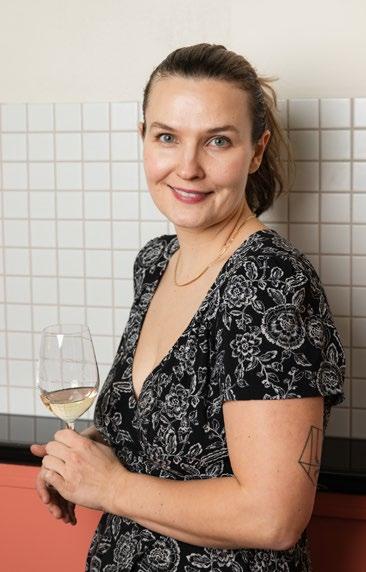
So which wines are at the top of this award-winning sommelier’s list of favourites?
“I recently went to New York and got to have a pinot noir from Sylvain Pataille from Marsannay in France. It was a fairly recent vintage; I think we drank 2019. It's a wine that’s very alive and bright and herbal, aromatic, unique, juicy and fresh,” she says, adding she’s enjoying the pendulum swing away from heavier styles of red wine.
“People have moved away from that, because they're a little bitter in that tannic structure, and you have to age them…and also your food choices are fairly limited when you have 15 per cent alcohol. It’s nice to have fresh, rich reds, because I like to drink wine; I don’t like to have to chew on it.”
As for whites, Jones is
enthusiastic about Portuguese Vinho Verde (“I love alvarinho”) and praises its “very bright and refreshing acidity,” noting that it's a natural choice for a location like Vancouver that’s rich in seafood.
When asked what’s exciting
you in Canadian wines, Jones says “I'm very much a fan of old vines Riesling from Tantalus in Kelowna. I love Syrah from Nichol in Naramata,” she says. “I’m quite B.C.-focused because I live and work here.” FH
60 FOODSERVICE AND HOSPITALITY JULY/AUGUST 2023 FOODSERVICEANDHOSPITALITY.COM SOMMELIER PROFILES
JEREMY WONG
IT’S NICE TO HAVE FRESH, RICH REDS, BECAUSE I LIKE TO DRINK WINE; I DON’T LIKE TO HAVE TO CHEW ON IT
At Don Alfonso 1890
Toronto, pandemic memories are melting away in the glow of a Michelin star. “As soon as we were open, there was a huge surge in people coming back,” recalls sommelier Justin Madol.
“We get people coming in with very high expectations. That’s what the Guide does –distinguishes you from other restaurants. When we opened the restaurant – and I was part of that opening team – that was always part of our plan: we want to be competitive with restaurants in New York and Paris and London,” he says.
Madol’s career trajectory has been far from predictable. Born in Conception Bay, N.L., he initially studied physics and geology, but detoured
Justin Madol Sommelier,

Don Alfonso 1890 Toronto
BY SARAH B. HOOD
after taking an elective course in cultural anthropology. “As I started seeing the world through different lenses, I became interested in film and photography,” he says.
Media studies naturally led Madol towards acting, filmmaking and a move to Toronto, where he was hired as a food runner with Susur Lee. What started as a side job became his main focus; soon he was studying for the CMS (Court of Master Sommeliers) exams, and he has never looked back.
With regard to wine trends, Madol is noticing interest in “emerging or re-emerging regions” such as Eastern Europe. “Georgia, Greece, Bulgaria; there’s tremendous value there.” He also points to lesser-known parts of major regions, such as France’s Jura and Savoie.
Likewise, “South America is starting to blossom and find its own identity,” he says. Argentina’s malbec was once “heavily oaked in the style of California, but is now starting
to find its own voice: lighter, peppery, very little use of oaks.”
From Italy, Madol names Alto Adige and the alpine reds of Piedmont, Valtellina and Friuli. In particular, he singles out G.B. Burlotto’s pelaverga – the grape from Verduno in Piedmont – as “spectacular, very low in tannin, with a beautiful fruit character and herbal flavour.”
Of Italian whites, he favours Friulian wines like Antonutti Ribolla Gialla, “a fresh beautiful wine that doesn’t lack complexity.”
He also holds Canadian wines in high esteem. “For me, right now, pinot noir and chardonnay from Prince Edward County, Ont. [are at the top of my list]. That’s where we’re doing Burgundian wine at a world-class quality,” says Madol. “Closson Chase: their South Close Chardonnay is really fantastic.”
For reds, he turns to the Okanagan Valley for “some really great pinot noir and Syrah. Quail’s Gate: their pinot noir is really light, really floral.” FH

JULY/AUGUST 2023 FOODSERVICE AND HOSPITALITY 61 FOODSERVICEANDHOSPITALITY.COM
WE GET PEOPLE COMING IN WITH VERY HIGH EXPECTATIONS. THAT’S WHAT THE GUIDE DOES – DISTINGUISHES YOU FROM OTHER RESTAURANTS
SOMMELIER PROFILES




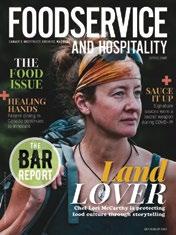
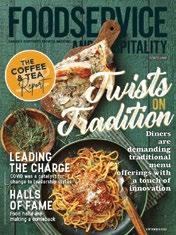
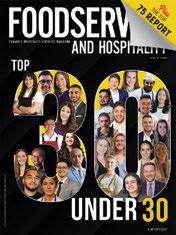
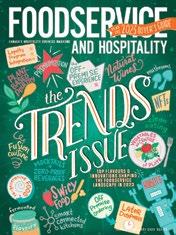

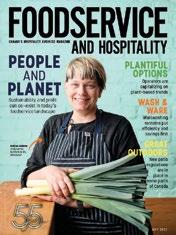
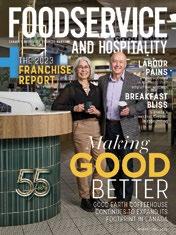
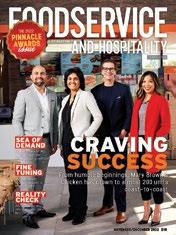
reprints For article reprints, contact: Danna Smith at dsmith@kostuchmedia.com
RAISING THE BAR
Hotel Lugano Dante’s bar showcases beverage innovation
 BY ADAM AND LARRY MOGELONSKY
BY ADAM AND LARRY MOGELONSKY
Implementing operational change is always difficult, and yet from the guest’s perspective it’s often the little touches that make the experience exceptional. In this case, why care about something as small as a new beverage offering? We point to the ‘halo effect’ where, in the guest’s mind, non-room amenities echo back onto overall property satisfaction.
Carlo Fontana is the owner/operator of the Hotel Lugano Dante in Lugano, Switzerland and its onsite Flamel Restaurant and Bar, which prides itself on being at the cutting edge of bar technology. The mission at Flamel is to highlight local Swiss tastes while elevating the concept of mixology by having every drink component produced entirely in-house.
At the centre of Flamel’s mixology tech is a BuchiRotavapor R-300 rotary evaporator, a pharmaceutical-grade distiller, costing approximately $16,000 plus accessories. The rotary evaporator allows the restaurant to bring new flavours into its drinks by extracting the 'soul' of each ingredient. Picture the Rotavapor as a modern still; it works under vacuum so that the evaporation point of each liquid occurs around room temperature. The result is that fragrances are kept intact.

While this price tag may induce sticker shock, it’s an example of pain now, profit later. The equipment costs and training were all amortized, but after that only small quantities of externally purchased bottles were required, resulting in an average internal bottle production cost of 50 per cent versus wholesale purchases.
Following standard recipes with some experimentation, Flamel uses this equipment to make its own gins, absinths, malts and liquors. Not only is the bar team allowed to become mixologists by crafting wild new cocktails, but they’re also immersed in the classical teachings of how vacuum distillation works.
Given the complexity of making literally everything from scratch, training of the five-person team is continuous and was fraught with mistakes at the program’s outset. Fontana notes, though, that this training encourages an ongoing dialogue amongst the team, distillers and other craftsmen, offering a profound bonding experience that severely curtails turnover. The process acts as a deeper form of continuing professional development by incentivizing the team to learn the technical skills of processing the raw materials into beverage ingredients.
With everything produced onsite, the only inputs are pure
Swiss grain alcohol with 98 per cent of other ingredients also from Switzerland and the remaining two per cent of raw spices sourced from around the world. Besides distilling different types of citrus fruit, many of the herbs used come from the hotel’s nearby urban garden, while the team is constantly challenged to infuse unusual ingredients such as jalapeño, black garlic and horseradish.
Even with this laboratory mindset, management nevertheless keeps the menu approachable with twists on classic cocktails — a Negroni made from self-produced liqueurs or an Old Fashioned with Swiss rye whisky and diluted with birch water. Bonus points here on the sustainability front as this push for everything local has sharply minimized food miles insofar as the procurement of exotic raw materials.
For its bar ice, Flamel uses a technique called ‘directional freezing’ where microfiltered water is put in large insulating containers, and after about 48 hours, blocks of crystalline ice are formed with impurity residues at the bottom that can be separated out. Such blocks melt much more slowly and can be stored in the freezer instead of having to be thrown away every night.
Being avant-garde to the nth degree certainly generates that wow factor, but Fontana isn’t afraid to admit that it can alienate the lessadventurous visitors. The key to overcoming this challenge has been to wholly embrace the concept at every touchpoint of the hotel’s messaging so that guests are aware of how different Flamel is well before they arrive. Setting this expectation ensures that the surprise always skews positive when the finished blend is served at the table. FH
JULY/AUGUST 2023 FOODSERVICE AND HOSPITALITY 63 FOODSERVICEANDHOSPITALITY.COM BAR TECHNOLOGY
Larry and Adam Mogelonsky are partners of Hotel Mogel Consulting Limited. You can reach Larry at larry@hotelmogel.com or Adam at adam@hotelmogel.com
KEFIR
Kefir is made by adding kefir grains — which are a combination of yeast and bacteria — to milk, resulting in a thick, tangy beverage that tastes similar to yogurt but with less lactose than milk. When kefir grains and milk are combined, the bacteria in the grains help ferment and break down the lactose but kefir does contain some lactose, so it may not be appropriate for everyone with lactose intolerance. Studies suggest that kefir offers numerous health benefits and it’s believed to aid digestive health and reduce inflammation while boosting bone growth.

FUN FACT
In Korea, kimchi is a rich piece of “gastrodiplomacy,” or the practice of using food to foster relationships between nations and resolve disputes peacefully. The tradition of making kimchi — and bringing community together — actually has a name in Korean: Kimjang.

KIMCHI
At the heart of Korean cuisine is kimchi, traditional banchan (side dish) consisting of salted and fermented vegetables, most commonly using napa cabbage or Korean radish. A wide selection of seasonings is used, including gochugaru (Korean chili powder), spring onions, garlic, ginger, and jeotgal (salted seafood). There are hundreds of different types of kimchi made with different vegetables as the main ingredients. It’s often described as having a sour, spicy, salty, and even umami flavour. Made through a process called Lacto-fermentation — it utilizes the bacterium Lactobacillus to digest sugars into lactic acid, which gives the kimchi its characteristic sour flavour — Kimchi is naturally rich in probiotics
KOMBUCHA
Kombucha is a fizzy, tart and flavourful fermented tea made from either green or black tea that offers these drinks’ potent health-promoting properties. It is made by fermenting sweetened tea with starter kombucha and a gelatinous pancake-like substance called a Scoby, or symbiotic colony of bacteria and yeast. The yeasts eat most of the sugar in the tea, transforming the liquid into a slightly sour, refreshingly fizzy, fermented (but largely non-alcoholic) beverage that tastes of tart green apple mixed with deep stone fruits. Kombucha contains probiotics that encourage gut bacteria diversity and aid digestion, as well as antioxidant properties.
The name kefir comes from the Turkish word “keyif,” which refers to the “good feeling” a person gets after drinking it
Fermenting, the traditional method of preserving food, addresses the challenge of reducing kitchen waste by providing a way to preserve unused ingredients while also increasing the consumption of functional foods.
Here are three examples of popular fermented foods making appearances on restaurant menus.
FUN FACT: Kombucha’s roots can be traced to China around 220 BC, where it was prized for its healing properties. The tea made its way to Europe in the early 20th century and is known by various names in different countries — kambucha in Russia, kombuchaschwamm in Germany.

64 FOODSERVICE AND HOSPITALITY JULY/AUGUST 2023 FOODSERVICEANDHOSPITALITY.COM
FUN FACT
Fermented foods are on the hot list for today’s chefs
HOSTED BY ROSANNA CAIRA
FEATURED PODCAST GUESTS
E68. A PASSION FOR COOKING ADAM LaFLEUR CHEF

TREVANE SANDERSON CHEF
E67. THE SHIFTING MARKETPLACE VINCE SGABELLONE CIRCANA









E66. MONEY MATTERS JACOB MANCINI CWB FRANCHISE FINANCE E65. CHANGING THE NARRATIVE TREVOR LUI CHEF | RESTRAURATEUR






Check out the Table Talk podcast to listen to conversations between Foodservice and Hospitality’s editor and publisher Rosanna Caira and industry leaders speaking about the issues impacting the dynamic foodservice industry. TABLE TALK podcast episodes are available at https://www.foodserviceandhospitality.com/category/media/podcast/ or find them

on and




Visit today. www.foodserviceandhospitality.com foodserviceandhospitality.com 5 Reasons to visit Polls on important topics 5 1 News from across the industry 2 Exclusive Content 3 Videos and podcasts 4 Calendar of coming events foodserviceandhospitality.com












































 BY VINCE SGABELLONE
BY VINCE SGABELLONE


 BY AMY BOSTOCK AND NICOLE DI TOMASSO | PHOTOS BY: WAYNE LINDO
BY AMY BOSTOCK AND NICOLE DI TOMASSO | PHOTOS BY: WAYNE LINDO

















































































































































 BY NICOLE DI TOMASSO
BY NICOLE DI TOMASSO







 BY SUZANNE CHIN-LOY
BY SUZANNE CHIN-LOY








 BY NICOLE DI TOMASSO
BY NICOLE DI TOMASSO










 BY SARAH B. HOOD
BY SARAH B. HOOD

























 BY ADAM AND LARRY MOGELONSKY
BY ADAM AND LARRY MOGELONSKY
















